#but her hair is the most distinct trait of her design...
Text
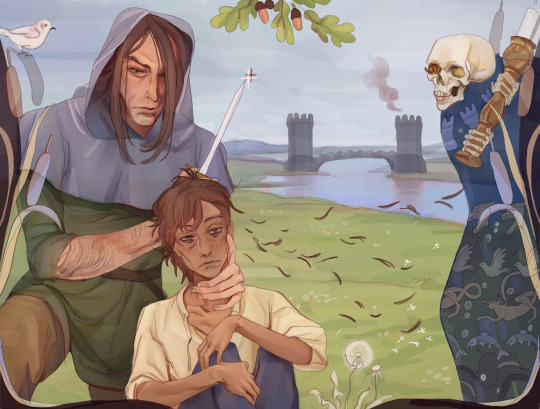
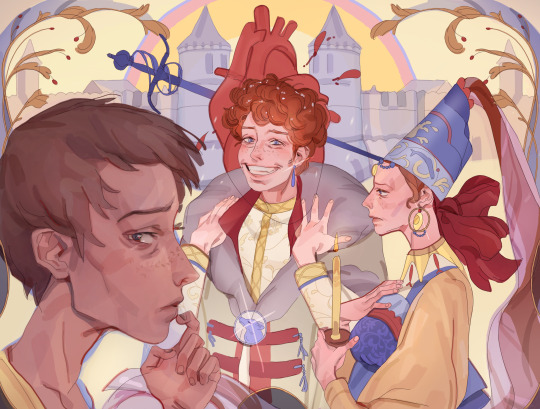
The Hound had hacked handfuls of her hair off only two days past. He was an even worse barber than Yoren, and he’d left her half bald on one side. Robb won’t know me either, I bet. Or even Mother. She had been a little girl the last time she saw them, the day Lord Eddard Stark left Winterfell.
ASOS, Arya X
#asoiaf#asoiaf art#a song of ice and fire#a storm of swords#asos#arya stark#robb stark#catelyn tully#catelyn stark#the hound#sandor clegane#the stranger#i think ill rest and draw some sketches now#sandor looks kinda small ughh i just could't fit him into the frame properly#looking back on it i think i could do him justice#catelyn and her hair is an interesting subject to me#realistically i think she would hide her hair entirely since she is so devoted to the faith..#but her hair is the most distinct trait of her design...#so i made something inbetween....#my art#valyrian scrolls
1K notes
·
View notes
Text
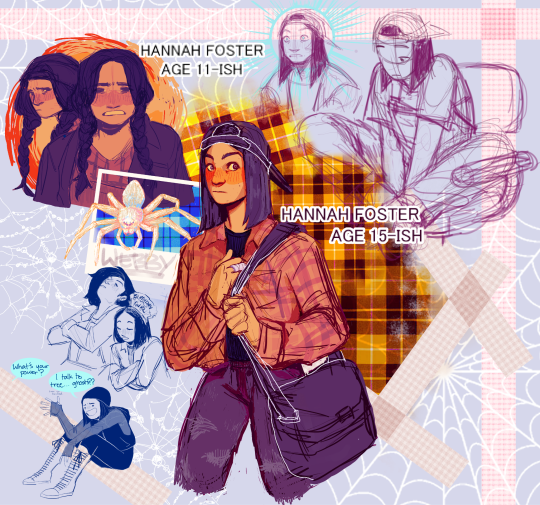
My favorite Conduit Of The Horrors 🩵
Rambles and art stuff under the cut
I love thinking about the primary trio post-nmpd, and there have been some really cool headcanons floating around, and long story short I rewatched Yellow Jacket and I have some ideas in the works. I don't know if this is post-Yellow Jacket or in the middle of it or what, I'm not actually thinking that deep about it I'm just having fun lol. For reasons I needed to have a finalized design for Hannah soooo-
I managed to seriously screw myself over by deciding to try and draw 2 characters I adore that are played by four extremely different looking actors. It was frustrating, but interesting to try and pick out what I thought the most important features of each version was.
So like, for BF Hannah I just used Kendall Nicole as the reference, easy peasy. But aging her up was a bit of a juggle. Eventually I ended up kind of grafting Lauren's expressions onto her face shape, which I also referenced Angela Giarratana for. Just to get that familial connection in there. It really helps that they both have that distinct chiseled chin, it's really fun to draw and fairly easy to replicate. (Side note, Lauren has an incredible ability to suddenly look like a deer in the headlights out of nowhere. The nervous energy that rang through her performance as Hannah was amazing, and I couldn't get over how damn expressive her eyes were)
I was gonna have a more detailed drawing of Ethan in there, because I absolutely love their relationship, but I chickened out. I ended up basically just drawing Joey's version with slightly shorter hair that is longer on one side, like a half-mullet thing. This is partially to try and synthesize the two versions in my head aesthetically, but mostly it's to differentiate him from Pete. Pete is a little difficult too, I actually really like how Nick Lang played him and wanted to incorporate some features from there, but I decided to save it for another day because I was giving myself a headache. Honestly a lot of the stuff is just hair texture, cause one of the most defining traits for their designs in my head was the way their curly hair was styled. But at the same time Joey's current haircut is damn iconic and I love being able to swing it around for the drama Ghibli-style
#arachnophobia#arachnophobia tw#spider tw#spiders tw#hatchetfield#hatchetfield fanart#starkid#starkid fanart#yellow jacket#nightmare time 2#nightmare time#black friday musical#hannah foster#ethan greene#coffeepaintart#wow there was a lot of jazz hands during that murder
447 notes
·
View notes
Text
as a long time fan of supergiant games and as someone who was obsessed with greek mythology as a child, i am EXTREMELY pumped about hades II. but also very curious about the new main character’s design. i feel like sgg (really, jen zee specifically) usually does a really good job of telegraphing their designs so that if you know the most basic things about a god, you can recognize them on site based on their design.
from the shape language to the posing to specific visual elements, they make sure that even at a quick glance the characters are not only distinct from one another, but have enough references to their domain and mythology that they are very recognizable.

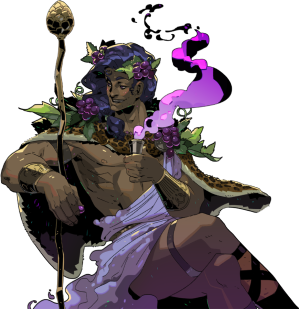
i think demeter is one of my favorite indicators of this and one of my favorite hades designs over all. she’s not interpreted in the way a classic demeter is, and that’s part of what’s perfect. she’s been built at with little hints and references in other characters’ dialogue that paint her as critical, overbearing and not exactly trustworthy. and when you see her you’re like, “what, this is the goddess of the harvest?” with the absence of persephone and her casting the earth into famine, it makes sense that she doesn’t look bountiful, that her cornucopia (still the classic visual reference to demeter) is empty, her wheat frozen.

but melinoë is different. melinoë is a bringer of nightmares, a goddess of ghosts. her mingled heavenly and infernal heritage manifests in her primary physical trait: a body that is split down the middle, half white and half black. this is basically her most defining physical characteristic (the other being that she wears saffron, which is bougie as hell but not the point), but here is her design from the hades II trailer:

i see the saffron, see reference to her ghostly/undead connections, and there is an element of her half-and-half complexion with those black moon armor (maybe?) coverings on her right arm and leg. but when i first saw this design i thought she was an original creation (like zagreus*), not an existing god. i’m interested to see if this means they’ll be changing core parts of her mythology (and to see if that’s reflected in her design) and to see what direction she’s headed in but really this whole long post has just been building up to me saying
WHY DIDN’T THEY GIVE HER SPLIT DYE HAIR
PLEASE IT WOULD HAVE BEEN SO PERFECT
almost every visual interpretation of melinoë, even if they don’t split her body into white and black halves like a white and black cookie, gives her a split dye. and maybe they wanted to avoid what everyone else was doing, but i feel like melinoë is unknown enough that that isn’t really a big deal. idk. i just think it would be neat. that’s all.
(*yes i know there is a zagreus in greek canon that is the first iteration of dionysus and is the son of persephone and zeus but i feel like game zagreus resembles his mythological counterpart so little that he’s basically an original creation, and maybe they’re doing the same with melinoe! since she is also technically the child of zeus and persephone**)
(**depending on the canon it’s either zeus disguised as hades or zeus and hades are two aspects of the same being)
2K notes
·
View notes
Text
thinking about how insane the demon slayer art style and character design is. like, the the nose, mouth, and face shapes of everyone in the main cast are virtually identical regardless of gender, and yet every single character has a very distinct personality at first glance. And unlike other popular anime, it isn't their rainbow hair colors or painstakingly customized uniforms that help the audience tell them apart (though I do love their outfits).
It's almost entirely their eyes.
The best example of this is probably shinobu. Her eyes are enormous, round, and purple, things associated with femininity. However, they have no pupil or sclera and have a matte gradient effect. The gradient effect gives an appearance similar to an insect's compound eyes, giving a nod to her abilities and character aesthetic, but more importantly, the lack of reflected light makes her eyes look completely dead. This tells you everything you need to know about shinobu's character. She's beautiful and graceful in her appearance and mannerisms, but she's also lost the most important thing in her life, is capable of great cruelty towards her enemies, takes a sadistic delight in their pain, and her cheerful and benevolent persona is a facade. Basically, by just drawing a couple of carefully shaded circles, the artist lets you know that even if this character acts lively and upbeat, that fact that there is no light behind her eyes shows that it is false.
This is thrown into even greater contrast when a flashback is shown of kanae, shinobus late sister, who we know that shinobu seeks to imitate with her faux cheerfulness. Though their faces are identical, their eyes couldn't be more different. Where shinobus eyes are matte and reflect no light, kanaes are glossy and have three enormous highlights in each eye, making her look literally starry eyed, and that's reflected in her personality. Kanae is shown to kind, overly idealistic, and optimistic to the point of being airheaded: the exact opposite of shinobu, who is bitter, cunning, and capable of great cruelty.
Anyway demon slayer really makes the most of visual storytelling in even its smaller details.
Some other highlights in character design:
rengoku's constantly wide eyes with their rings of contrasting color that almost resemble an optical illusion perfectly convey everything about his most important character trait, his unrelenting intensity. Additionally, depending on context, his wide-eyed appearance can either be played for laughs or deeply unnerving, depending on whether his neverending enthusiasm is being directed towards complimenting tasty food or carving up his enemies with a smile.
Obanai has heterochromia identical to that of a cat, and let's be real, his personality is pretty cat-like. He's proud, disdainful, and judgemental of others, but he is also full of unconditional love for Mitsuri, even if he usually only shows it by quietly enjoying her company. Plus, it's also revealed that the reason obanai fell in love with mitsuri is because she is a genuine person who doesn't push his boundaries, giving him someone he can truly be comfortable around. Anyone who's interacted with a cranky stray cat before can tell you how familiar that sounds.
Nezuko has three separate sets of eyes throughout the series. As a human, her pupils are pink with complicated black shading and with a white highlight, once again hinting at her innocence. As a demon she usually has pink eyes with a circular highlight, but all the shading and therefore all the "depth" is gone. Since she doesn't remember that her family was killed and has somewhat regressed to a childlike state, nezuko still has her innocence (as shown by the highlight) but has lost her complexity that made her fully human. When she becomes enraged, her pupils become dark and slitted and her irises lose their reflective sheen, showing that not only is she monstrous, she has temporarily regained the capacity for anger and other dark emotions, and lost the ignorance/innocence that keeps her monstrous instincts at bay.
Muichiro has no memory of anything but the last three months of his life, and likewise, his eyes are foggy and dull
In the case of aoi, the square, blocky shape of her pupil implies a lot about her character: the fact that she's somewhat ordinary and a reliable, steady ally, even if she can be a little stiff.
I'm fairly certain that tanjirous red eyes were supposed to have narrative importance and signal that he is a descendant of yoriichi until it was decided at some point that yoriichi had no children and tanjirou was a descendant of a friend of yoriichi instead (either that or the reveal was planned from the beginning and the eye color was a red herring), but that's beside the point. Tanjirous eyes are red with dark shading, and do not have a highlight, though they do have a white pupil. This combination represents tanjirous emotional maturity, the combination of negativity and positivity. Unlike shinobu, who has no light in her eyes and is controlled by her resentment, and kanae, who has nothing but light in her eyes and was idealistic to the point of foolishness, tanjirou has both. Yes, he has suffered, he lost almost his entire family, even after he dedicated his entire self to caring for them after his father's death. However, tanjirou is still a fundamentally compassionate and hopeful person. No, Tanjirou is far from the first shonen protagonist who is kind and a genuinely good person (Luffy, Naruto, and Goku come to mind), he is one of the more emotionally intelligent ones. Tanjirou empathizes with the demons and recognizes the suffering that made them into monsters, but at the end of the day, he still kills them. There is no talk no jutsu, there is no transformation of enemies into allies, and there is no sparing of enemies out of respect for their fighting prowess. Though Tanjirou recognizes that demons are tragic and pitiful, he also knows that they are creatures that survive only on the slaughter of innocents. This isn't to say that stories about redemption or forgiveness or once-feared villains turning into the protagonists wacky neighbor are inherently bad, far from it. But for the story that demon slayer is, tanjirou is the perfect fit. And you can tell, just by looking in his eyes.
#demon slayer#kimetsu no yaiba#kny#tanjirou kamado#nezuko kamado#iguro obanai#rengoku kyojuro#muichiro tokito#shinobu kocho#kanae kocho#aoi kanzaki
704 notes
·
View notes
Note
Review Kyrri? My first neopet.




Kyrii are vaguely weasel-like, but that's probably not what you remember them for. If you're like me, you remember them for A) having extremely luxurious manes, and B) being smug and vaguely conniving. The design itself is fine albeit somewhat plain, but it's those additional traits that help them stand out a bit. (They're also allergic to apples—not the only species with an allergy to a certain food, but I feel like they get it played up the most.)
Visually, Kyrii have a standard bipedal pose with a complimentary lighter tint of the main color used for the underbelly, including the jaw, and the inside of their ears, which have a nice teardrop shape to them. The mane, arguably the driving concept behind the species, is also very pretty, having lots of curves and swishes to it that really give it that full, rich look. I also like how the tail and the mane are one unit, so the tail looks like the hair and vice versa.

In terms of customization, Kyrii got the short of the stick. They're not the worst by a long shot, but the big problem here is the face. It's too short, too wide, a little too round, and it doesn't taper the way it should. Technically speaking it's a subtle difference, but it really does majorly change the way the species looks, and not in a good way. They also lost that vaguely smug look, possibly due to having the head turned upwards more.
On top of the face, the body also got a bit screwed up, as both the stomach and forearms became too bulky, whereas originally the Kyrii was a pretty lanky species. Other odd decisions including running the underbelly up onto the jaw, which kind of affects the way the mouth reads even if it has a nice shape to it, and reducing the amount of shine in the mane. On the plus side, the mane itself at least looks better—it's much fuller than it was originally and the really janky shape of the fur on top of the head has been majorly improved.
Favorite Colours:

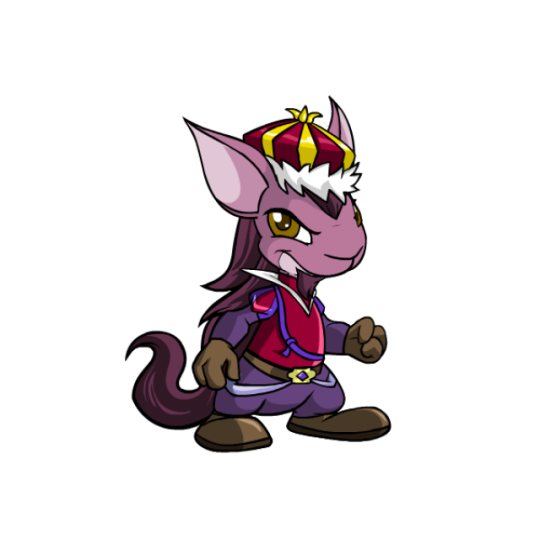


Royal: Royal Kyrii are a good example of how badly customization messed up the species, as they went from being quite beautiful to incredibly awkward, in part due to their faces being too wide and round and in part due to some weird decisions on the clothing (such as the Royal Boy loosing his cape and large sleeves and the Royal Girl loosing the entire back of her dress in addition to her hair braids no longer wrapping around the back of her head).
However, the original designs are fantastic! Both versions are good and have their own unique flavor (something royal pets sometimes struggle with). The Royal Girl has a lovely elegant look with a long muzzle, pretty dress, and a very nice turquoise and white color palette. The Royal Boy has a primarily maroon palette with an extra over-the-top mane and a vaguely swordsman-like outfit.
The poses are also full of personality, especially with the long-defunct battledome art bring us these gems:
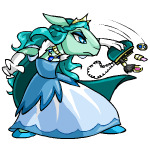
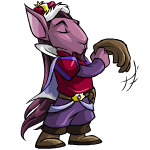
10/10 no notes.

Pastel: Pastel pets are usually just taking a pet and applying pastel colors to the design as-is, so the pastel Kyrii really stands out by having the addition of stripes added to its mane. This gives it a very distinct look and adds a fun rainbow aspect to the design. The palette itself is also nice, juggling five colors at once without it feeling overwhelming or too busy. Just really nice!

Water: Water is a very hit-or-miss colour and it depends entirely on how good the art is, but thankfully they really nailed it with the water Kyrii. The white-foam mane draws attention to the most important part of the design and has a good amount of depth, especially int he darker areas at the base, while the body has a nice subtle gradient, highlights, bubbles, and ripples to give it that water-y feeling.
41 notes
·
View notes
Text
More than "Sheer Coincidence": The Antisemitism of Disney's Animated Villains
This is a paper I wrote for a Jewish studies class. It was inspired by a tumblr post, so I thought it was fitting to share here. Most will be under a "read more" link, as it is about 25 pages including the bibliography. Please feel free to ask questions, and enjoy.
_______
On June 19, 2022, Tumblr user fantastic-nonsense published a post about Disney’s 2010 animated film Tangled, and the film’s villain, Mother Gothel, which starts, “*sigh* the ‘Mother Gothel is an anti-semitic caricature’ discourse is going around again.” They argue that, because Mother Gothel’s appearance was based on two non-Jewish women, Gothel’s voice actress Donna Murphy and singer Cher, any claim that Mother Gothel’s large nose or dark, curly hair resemble antisemitic caricatures was simply projection. The goal of Gothel’s design was to make her as visually distinct as possible from Rapunzel, not to make her “look Jewish.” They continue with a question:
“[I]f Gothel was blonde with a ‘normal’ nose…but literally nothing else about her changed, would you be saying that she’s an anti-semitic stereotype?...All I’m saying is that Gothel (and thus Tangled) is unreasonably linked to those tropes…There is a very distinct difference between being actively anti-semitic and Tangled, which has anti-semitism being projected on it because its villain bears passing similarity to anti-semitic caricatures out of sheer coincidence.”
The user has since deleted the original post, but a reblog remains further arguing their point. In an attempt to defend the film from criticisms of antisemitism, fantastic-nonsense stumbles upon a fundamental conundrum of analyzing villainous characters such as Mother Gothel: Is it possible to create a villainous character that avoids all potential antisemitic pitfalls? And, despite fantastic-nonsense insisting it’s a “sheer coincidence,” why do so many Disney villains have stereotypically Jewish traits?
Unmasking Antisemitism: The Origins of Disney’s Jewish Villains
Jewish people have long been viewed as villainous in various gentile European cultures, a view brought to the United States through colonization. Accusations of blood libel go back to the 12th century and have been noted from eastern Europe to England. Famous authors and playwrights such as Charles Dickens and William Shakespeare indicate a centuries-long trend of villainous characters defined by their Jewishness, and infamous business magnate Henry Ford published accusations of predatory banking practices and fervent Christian hatred in his pamphlet series The International Jew in the early 1920s, before Disney was a studio. With centuries of association between Jews and villainy as a backdrop, there is little surprise that Disney turned to antisemitic tropes in the construction of one of its earliest villains.
The 1933 short Three Little Pigs is remembered as one of the most successful shorts from Disney’s Silly Symphonies series. Not only was the film the source of the song “Who’s Afraid of the Big Bad Wolf?” which became an anthem to “Depression-weary audiences,” but the film was a milestone in character development, versus the characters existing only to serve gags. Walt Disney was so proud of the finished film, he said, “At last we have achieved true personality in a whole picture.” Part of developing the characters’ personalities was creating a menacing villain, an archetype Disney would come to be known for, and the Big Bad Wolf is one of its earliest successes on this front. The film follows the typical narrative of the fairy tale, with a trio of pigs each building their own house, one of straw, one of sticks, and one of brick. We see the Wolf approach them as the first two are frolicking after constructing their flimsy houses, drool pouring from his mouth filled with sharp teeth. While the Wolf is able to simply blow away the straw house, the house of sticks proves to be a bit stronger, and he resorts to trickery, pretending to give up and leave the pigs alone before returning dressed as a sheep and asking for shelter. The pigs sees through this disguise, refuse him entry, and his anger gives him the strength to blow down the house of sticks. When the pigs flee to the house of bricks, the Wolf returns with a new disguise: a Jewish peddler.
Wearing a large brown overcoat, green-tinted glasses and a skullcap, and adorned with a fake beard and long nose, the Wolf knocks on the door of the brick house with a rack of brushes around his neck, proclaiming in a Yiddish accent, “I’m the Fuller Brush man, I’m giving a free sample!” The pig from the brick house, quickly seeing through his tricks, proceeds to hit him with said free sample before pulling a welcome mat from beneath the Wolf’s feet, causing him to land on his face and his false nose to bend 90° towards the sky. The Wolf rips off the disguise in anger, and the short continues.
The association of Jews and the peddling profession arose during the 19th century, as peddling helped facilitate the mass migration of Jews across the globe during that time. Peddling was more accessible to poor immigrant Jews than owning a store, and the freedom of self-employment allowed them to maintain their own schedule and keep Shabbat, unlike factory jobs. As most peddlers did not maintain the job for more than a decade, nor pass it down to their sons, peddlers represented a lack of assimilation, perpetually tying the occupation to otherness, which facilitates the villainization of peddlers through their Jewishness.
The stock character of the “Jew peddler” quickly entered popular culture, giving all manner of creatives, from commentators to novelists, a new punching bag in their library of cultural symbols. As Hasia Diner describes the figure in her book Roads Taken: The Great Jewish Migrations to the New World and the Peddlers Who Forged the Way, “Sinister and shadowy, exotic or absurd, he made a good subject for mockery, with his odd accent, his clothing, his lack of a fixed abode, and his distinctive bodily features: in this milieu, a prominent hooked nose was a sure sign of Jewishness, a long beard a likely trait as well.”
Director Burt Gillett created a costume for the Disney short’s villain which ticked off every box in the “Jew peddler” playbook. A symbol of “trickery, otherness, and greed,” and pervasively believed to be dishonest, the peddler costume serves not only as a disguise for the Wolf, but to highlight those traits in his villainous hunt of the pigs. Audiences would have had a pre-existing cultural understanding of the Jewish peddler as a costume. Throughout the 19th and into the early parts of the 20th century in the United States, local newspapers reporting on masquerade parties described “Jew peddler” costumes among princesses and pirates. With his two costumes being a play on the phrase “a wolf in sheep’s clothing” and the known manipulative figure of the Jewish peddler, the characterization of the Wolf is clear: He is so manipulative, even his choice in costumes shows off his deviousness.
There is a more intelligent side to the gag of the Jewish peddler costume; not only would the Wolf seem less threatening dressed as a Jewish peddler, but the pigs would assume he kept kosher and didn’t eat pork, easing their worries. Still, the use of antisemitic stereotypes to emphasize the Wolf’s dangerous and manipulative nature has been recognized as offensive, including by the company itself. A 1948 re-release of the short edited the animation to remove the antisemitic costume. The Wolf still dresses as a peddler, but without any Jewish signifiers, maintaining the overcoat but swapping the skullcap and green-tinted glasses for a bowler hat and clear ones, and forgoing the nose and beard altogether. Initially, the original audio was maintained, as the new animation of the wolf still matches the original dialogue, but a new version of the Wolf’s audio was recorded and replaced the Yiddish accent at a later date. Instead of hawking his wares in a Yiddish accent, the Wolf puts on a low, unintelligent-sounding voice and tells the pigs, “I’m working my way through college!” This is the version of the short that is available on Disney+, where no mention is made of the short’s history or the edits that were made to it. Although the Wolf does not have the same notoriety as many of Disney’s villains from feature-length films, he didn’t fall into complete obscurity, making a cameo in Who Framed Roger Rabbit (1988) alongside the pigs, and appearing in the 2002 direct-to-video film Mickey’s House of Villains. 90 years after his first appearance, the Wolf’s legacy resonates in the designs and characterization, which Walt so highly praised, of the villains who came after him.
Hooked-Nosed Hags and Mincing Manipulators: Jewish-coding in 20th Century Disney Films
Disney took its first leap into feature-length animation in 1937 with Snow White and the Seven Dwarfs. Released only four years after Three Little Pigs, the film displayed a marked improvement in many areas of animation, particularly character design. While previous Disney shorts had largely starred animals, Snow White featured an entirely human or human-like cast. Unable to differentiate between hero and villain by species, designers needed other visual signifiers to indicate a character’s villainy or heroism to the audience. As former Disney character animator Andreas Deja wrote on his blog, where he frequently catalogs stories from Disney’s older films, “[Walt] Disney insisted on strong contrast between good versus evil, and that needed to be clear in the characters' design as well as their acting.”
In 1749, German philosopher and playwright Gotthold Ephraim Lessing wrote in his play Die Juden (The Jews), “And is it not true, their countenance has something that prejudices one against them? It seems to me as if one could read in their eyes their maliciousness, unscrupulousness, selfishness of character, their deceit and perjury.” For centuries, antisemites have posited that Jews not only are evil, but look evil based on their natural physical appearances. This idea quickly made its way into Disney’s understanding of character design. Although Three Little Pigs’ Wolf is the only villain who takes on an explicitly Jewish appearance, Disney has designed its villains with stereotypically Jewish traits as a visual indicator since its first feature film. This notion of visual signifiers of internal traits is derived from race science, a concept the American government had latched onto with the Dillingham Commission, a Congressional committee analyzing immigration in the United States at the end of the 19th and beginning of the 20th century. In the Commission’s Statistical Review of Immigration, published in 1911, the “Hebrew” people were the third-lowest ranked group in the “Caucasian race.” As Jews were considered one of the least desirable groups of white people, common traits amongst them were quickly associated with villains, regardless of their background.
Snow White’s Queen Grimhilde does not have many stereotypically Jewish traits upon first glance. This is essential to the story, as the Queen was previously the “fairest one of all” until her title was taken by Snow White, whose beauty outshone hers even while dressed in rags. Because she is also beautiful, she could not be designed with ugly, villainous, “Jewish” traits. However, when she finds out the Huntsman failed to kill Snow White, she adopts a disguise in order to poison her without being recognized, much like the Wolf in The Three Little Pigs. Her disguise transforms her from a beautiful, regal woman into a decrepit witch, with a massive, hooked nose and deep eye bags, both common traits in antisemitic caricatures, marking her new form as Jewish. Her transformation marks her change into a more active villain role, pursuing Snow White herself instead of sending a henchman to find her. By the end of the film, the Queen’s internal ugliness, through her vanity and envy of Snow White, has physically manifested, showing that she was never really as beautiful as the kind-hearted and button-nosed Snow White.
The contrast between the Aryan features of Disney’s leading ladies and the ugly and Jewish-coded traits of their female villains continued for decades. Cinderella’s stepmother, Lady Tremaine, and her daughters are both drawn with large noses compared to Cinderella, who has a button nose similar to Snow White. Lady Tremaine is given a hooked nose and heavy-lidded eyes, just as Queen Grimhilde had in her disguise. Her less exaggerated appearance befits her more realistic villainy, portraying personal greed and child abuse rather than a magically enhanced poisoning plot. The stepsisters, on the other hand, are given bulbous noses, similarly to Snow White’s seven dwarves, largely indicating ugliness rather than Jewishness. In both cases, their designs are “more reminiscent of 101 Dalmatians male villains Horace and Jasper, rather than typical Disney female features.” All three are given features reminiscent of Disney’s male character designs, compared to Cinderella’s “proper” femininity, which, at this point in Disney’s history, was always white.
Maleficent and Aurora’s designs in Sleeping Beauty function similarly. Maleficent’s pointed nose, prominent horns, which Jews are often accused of having, and green skin make her appear inhuman compared to Aurora’s upturned nose and blonde hair. Maleficent’s appearance is also juxtaposed against the film’s good fairies, Flora, Fauna, and Merryweather, who look entirely human aside from their wings. Sleeping Beauty also furthers the concept of appearance reflecting personality, giving the cruel Maleficent an unnatural skin tone, and displaying her most powerful form, a dragon, at the climax of the film. It is important to note that both Maleficent and Queen Grimhilde use magic and potions in their villainy, while their respective princesses do not use magic on their own. Judaism and witchcraft have long been associated in European Christian concepts of witches, and these films both bring that trope into a new world of storytelling.
While Disney’s early female villains were largely coded as Jewish by their designs and the juxtaposition between them and Disney’s respective female lead’s designs meeting Euro-centric standards of beauty, male villains’ coding comes at the nexus of homosexual and Jewish male stereotypes, alongside their designs. In her description of the coverage of Leopold and Loeb’s 1924 murder trial, Sarah Imhoff wrote that “the press coverage did not often explicitly cite their Jewishness because it did not need to. Journalists and commentators were able to convey Jewishness without stating it directly. Certain characteristics—intellectual, physically weak, not fit for manual labor, perverted, and prone to illness and psychiatric imbalance—painted a gendered portrait of a Jewish man even without reference to race or religion.” Many of Disney’s male villains fit such descriptors, indicating their Jewishness to the audience without the religion ever being mentioned. Additionally, these descriptors–particularly “perverted,” which at the time was a euphemism for both religious and sexual deviance-- are often applied to gay men, while homosexuality was treated as its own psychological issue. Both queer and Jewish men are seen as feminine, not meeting the white Christian ideal of a strong, straight, and stable man. With such overlap, queercoding of male characters often coincides, intentionally or not, with Jewish-coding.
The effeminate, mentally unstable villain can be found as early as the 1950s with Peter Pan’s Captain Hook, a willowy man in a plumed hat prone to comedically anxious outbursts, with black, wavy hair and a large nose. Captain Hook is voiced with a British accent, as many of Disney’s male villains do (including Jafar, Scar, and Governor Ratcliffe, whose fitting British accent stands out against John Smith’s strangely American one), which is not typical of Jewish characters in American media. However, “unlike the good characters of the film, who are endowed with physical features more generally identified with Northern European characters, the Captain Hook character would appear to be more Southern or Eastern European…he is the villain, and the writers and artists chose to give him physical characteristics that somehow reflect his villainy.” The author does not mention Jews in his analysis, but the majority of American Jews are descended from Eastern European Jews, and the comparison is bolstered by the non-visible Jewish stereotypes Hook fits as well. Again, Hook’s features are contrasted against Peter Pan and Wendy’s straight, brown hair and upturned noses, matching his implicitly Jewish characteristics with an implicitly Jewish appearance.
The Disney Renaissance, a period from 1989-1999 which saw massive success for Disney and a notable Broadway influence on the films, also saw a barrage of male villains with notable Jewish-coded traits. While Aladdin’s Princess Jasmine has a slightly larger nose compared to her white princess predecessors, Jafar still has much more prominent and hooked nose and heavy-lidded eyes, traits even more prominent in early iterations of his design. Jafar fits many of the descriptors applied to Leopold and Loeb in lieu of calling them Jewish; he is a manipulative magician with a wiry frame, contrasted by Aladdin’s larger build and ability to run and swing around Agrabah to avoid guards, and becomes mad with power after wishing to become a genie himself. Appearance-wise, in addition to the Jewish-coded traits mentioned above, Jafar’s dress-like robe and elaborate headpiece give him a feminine appearance next to Aladdin’s pants and vest, and bare muscular chest, affirming his masculinity. Imhoff notes that, because of Jews’ intelligence and lack of physical prowess, the prevailing stereotype was that “Jews tended not to commit courageous crimes, but rather chose crimes where they did not have to confront their victims directly.” She extrapolates, “Jewish men’s crimes were crimes of intellect, not passion; manipulation, not aggression; outsmarting, not overpowering.” Jafar displays these methods of criminality multiple times, tricking Aladdin into fetching the genie’s lamp from the Cave of Wonders, lying to Jasmine about Aladdin being sentenced to death, and hypnotizing the Sultan with his staff to steal an heirloom jewel. Although Aladdin uses his wits to defeat Jafar by trapping him in the magic lamp, his physical strength both make him more attractive and capable in Jasmine’s eyes than Jafar, who pursues her for political gain.
The Lion King’s Scar is a more prominent example of the juxtaposition between the strong but simple hero and the weak but wily villain. After feminizing himself, proclaiming “I shall practice my curtsy,” when his brother King Mufasa tells him that Simba, Mufasa’s son, will one day be Scar’s king, Scar says, “Well, as far as brains go, I got the lion’s share. But when it comes to brute strength, I’m afraid I’m at the shallow end of the gene pool.” While the heroic Mufasa, and later Simba, are muscular and broad, Scar is drawn almost emaciated, his hips swinging with each step in an effeminate manner. Like Jafar, Scar rarely involves himself directly in his crimes, sending his hyena henchmen to do his dirty work while he devises a plan. While animated lions lack the physical traits associated with Jews, Scar’s strangely dark mane contrasts with Mufasa and Simba’s reddish fur, and the dark circles of fur around his eyes resemble both heavy eyelids and eyeshadow, serving as both a feminizing and Jewish trait. When Scar and Simba fight at the climax of the film, Scar resorts to gaslighting, trying to convince Simba that he is responsible for his father’s death, and tricks, throwing burning ashes into Simba’s face, rather than beating him with brute strength.
Pocahontas’ Governor Ratcliffe fits oddly into the field of simultaneously feminized and Jewish-coded villains. His purple outfit, braided hair, and posh mannerisms make him by far one of Disney’s most effeminate villains, and he is one of the most explicitly money-hungry villains in Disney’s film library, singing lyrics such as “It's mine, mine, mine/For the taking/It's mine, boys/Mine me that gold!” blatantly assigning Ratcliffe the stereotype of the greedy Jew. Yet the historical setting of the film, 17th century Virginia, makes it highly unlikely that Ratcliffe could possibly be Jewish. Still, his overwhelming greed and feminine mannerisms insert Jewish stereotypes into even the most unlikely settings, highlighting the pervasiveness of the stereotypes beyond direct acknowledgements of Judaism.
Although Hercules’ Hades is less feminized than his 90s predecessors, his coding is bolstered by frequent use of Yiddish words in his dialogue, describing Hercules as “the one schlemiel who can louse” up his plan, calling him “The yutz with the horse!” when directing the titans to attack him, and convincing Hercules to fall for his scheme by telling him, “We dance, we kiss, we schmooze, we carry on, we go home happy.” Portrayed as a fast-talking swindler, calling back to the fear of peddlers Disney utilized in Three Little Pigs, Hades follows the trend of having a hooked nose and deep-set eyes, as well as being significantly weaker than Hercules, who is characterized throughout the film by his immense strength and lack of forethought. While Hades nearly succeeds in getting Hercules to kill himself by diving into the River Styx to save Megara, once Hercules achieves godhood and becomes immortal, all it takes is a single punch to knock Hades himself into the river and defeat him.
Both Hades and Jafar also play upon fears of not just homosexuality but sexually deviant heterosexuality in their respective films. While Jewish men were characterized as feminine due to circumcision in the late 19th century, “Jews were not thought to endanger society by their supposed homosexuality but rather by their evil heterosexual drives. […] But while family life was intact among the Jews themselves, it was, so racists asserted, directed against the family life of others.’” While neither Jafar nor Hades express genuine attraction toward their female leads, each interferes with their predestined heterosexual relationship with the male lead. When Jafar fails to retrieve the lamp from Aladdin before he uses it, foiling his plan to become Sultan, his parrot henchman Iago suggests that Jafar marry Jasmine as a means of becoming Sultan instead. Jafar proceeds to brainwash the Sultan into pronouncing him Jasmine’s fiance while she builds a relationship with Aladdin, and nearly succeeds in forcing her to marry him, before Aladdin interrupts his plan. Hades gained leverage over Megara after she made a deal with him for a man who left her, and has her woo Hercules only to sacrifice her, using Hercules’ emotions to manipulate him into nearly killing himself trying to save Megara. In both cases, genuine heterosexuality triumphs over “evil heterosexual drives.” Even with Aladdin’s Arabian-inspired setting and multiple mentions of Allah by the Sultan, conceptions of pure heterosexual love shaped by Christian values save the heroines from deviant, and implicitly Jewish, heterosexuality.
Across decades, genders, and settings, Disney has not only continued to rely on antisemitic stereotypes to communicate villainy through character design, but has developed its villains to incorporate increasingly specific stereotypes that have been applied to Jews for decades, if not centuries.
(Not Her) Mother Knows Best: Mother Gothel and the Blood Libel of Tangled
The 2000s was a time of experimentation for Disney Animation. As the success of the Renaissance began to fade, Disney turned to genres and technologies it hadn’t worked with before. The early 2000s saw an onslaught of films with unprecedented science fiction elements, such as Atlantis: The Lost Empire, Treasure Planet, Lilo and Stitch and Meet the Robinsons. Beginning with Dinosaur in 2000, Disney slowly made its way into the field of CGI animation, developing its technology at a rapid pace across films like Chicken Little, Bolt, and the aforementioned Meet the Robinsons. After this decade of experimentation, Disney released a film which combined the musical and princess elements of the Renaissance with the CGI it had been developing, releasing its first CGI princess film: Tangled. A reimagining of the fairytale of Rapunzel, the film has been a topic of discussion since its release for both its villain, Mother Gothel, who embodies a wide variety of traits, both in her design and characterization, that have been negatively associated with Jews; and its story, which bears striking similarity to a long-standing antisemitic canard: blood libel.
Beginning with accusations of using blood in religious rituals in the 12th century, in the 13th century, an additional accusation further vilify Jews: “Jews killed Christian children to obtain their blood, turning ‘ritual murder’ into ‘blood libel’ or ‘ritual cannibalism.’” Jews were not only accused of killing Christian children, but using their bodies for personal gain. Although Tangled forgoes any child killing, its prologue tells a chillingly familiar tale of the kidnapping and exploitation of a beautiful, blonde infant by a dark and curly-haired, crooked-nosed woman, adapting the blood libel narrative for a new audience, just as blood libel narratives have adapted to fit “changing cultural and political climates.”
In developing a story fit for a feature-length movie, Tangled adds magical elements to its narrative absent from the original fairy tale. In the film, a drop of sunlight fell to earth in the form of a flower with incredible healing capabilities. This flower is discovered by Mother Gothel, whom the audience meets as an old woman, who discovers a song which, when sung to the flower, makes her young. Her young appearance incorporates many of the antisemitic archetypes present in previous villains including long, black, curly hair, dark, hooded eyes, and a pointed nose with a bump. Gothel hides the flower to hoard its powers for herself, immediately establishing her as greedy, another common antisemitic trope. When the pregnant queen falls ill, the search party is sent for the mythical flower, hoping it will heal her. It is found, and after drinking a medicine made from it, the queen recovers and gives birth to a healthy girl, Rapunzel, with hair that is inexplicably bright blonde, as both the queen and king have brown hair. Aging and growing desperate, Gothel sneaks into the castle and cuts a lock of Rapunzel’s hair, only to discover that the hair, which has gained the flower’s magic, loses that magic when cut. She decides to kidnap Rapunzel, hiding her away and raising her as her own to continue utilizing the hair’s magic properties.
Many Disney films have utilized the contrast between villains’ and heroes’ character designs to indicate to the audience which role they play, with villains getting Jewish-coded features and heroes largely getting Western European ones. In nearly every way, Rapunzel and Gothel’s designs are completely opposites. Gothel’s frizzy dark hair could never be related to Rapunzel’s blonde, straight, silky mane. Gothel’s eyes are dark and hooded where Rapunzel’s are green and wide. Gothel’s nose is bumpy and hooked where Rapunzel’s is small and turns up. Gothel is curvaceous where Rapunzel is petite. In every way that Rapunzel fits the Aryan ideal, Gothel sits firmly in the category of other, even if both are white. Gothel’s foreign appearance was very intentional by the film’s director. In an interview, co-director Byron Howard said, “So, Gothel is very tall and curvy, she’s very voluptuous, she’s got this very exotic look to her. Even down to that curly hair, we’re trying to say visually that this is not this girl’s mother.” This goal in character design was repeated by him and co-director Nathan Greno in various interviews.
More than simply creating visual difference between Rapunzel and Mother Gothel, Gothel’s “voluptuous,” “exotic look” plays into the classic trope of the “Beautiful Jewess,” an orientalized beauty who tricks others with her alluring appearance, “‘her beauty conceal[ing] her powers of destruction.’” Gothel gaslights Rapunzel to keep her in her tower, convincing her that her naivete makes the outside world too dangerous for her to live in, and the contrast between Gothel’s curvy and sexualized body and Rapunzel’s petite frame only serves to bolster her claims. It is notable that early iterations of Gothel’s design show her without many of the visually “Jewish” traits she has in her final designs, with straighter hair tied back in a low bun, rather than the large curly hair seen in the film. Several designs have long, but not hooked, noses, and higher collars, avoiding the “Jewish seductress” aspect of her design. Yet these designs were rejected in favor of one influenced by two famous women: Donna Murphy, who voiced Mother Gothel, and Cher. Cher in particular was looked to for being “very exotic and Gothic looking,” playing into the orientalization of the Beautiful Jewess, where “the physical beauty and sensuality of the Jewish woman, her dark hair…were almost always described using orientalizing tropes and characteristics.” Although neither Cher nor Murphy is Jewish, both have the dark, curly hair and large noses associated with Jews, and the choice to base Gothel’s appearance off of them, particularly Cher’s “exotic” beauty, plays directly into pre-existing antisemitic tropes, whether intentionally or not.
Like Queen Grimhilde and Jafar before her, Gothel utilizes a disguise as part of her villainy. However, Gothel’s disguise, her false youth, is constant throughout the film, rather than temporary for one evil act. The Beautiful Jewesses’ “imaginary proximity to seduction, sexuality, theater, and dance, as well as to masquerade and costumes, certainly had just as much to do with their femininity—situated outside of bourgeois gender roles—as with their Jewishness.” Both Gothel’s Jewish features and her sexualized femininity play a role in the manipulative nature of her youthful disguise.
Not only do the narrative similarities to blood libel and the design of Mother Gothel play into antisemitic tropes, but more so than previous evil mother figures in Disney films, Gothel fits the “stereotype of the overbearing, over-involved, suffocating Jewish mother.” While Queen Grimhilde and Lady Tremaine force Snow White and Cinderella, respectively, into servanthood, Gothel pretends to care for Rapunzel, as exemplified in the song “Mother Knows Best.” In addition to warning Rapunzel of the dangers of the world outside her tower, she guilts her for wanting to leave her, singing “Me, I'm just your mother, what do I know?/I only bathed and changed and nursed you/Go ahead and leave me, I deserve it/Let me die alone here, be my guest.” Her overbearing and manipulative parenting strategies were a key part of her character, and of Rapunzel’s, according to Howard and Greno. In an interview with Den of Geek, Greno said, “If it’s a story about a girl who’s stuck in a tower, and we wanted Rapunzel to be a smart character, she’s being manipulated. So, if Mother Gothel was a mean villainess…you’d be like, Why is Rapunzel staying in the tower? You needed to buy that this girl would be there for 18 years. Mother Gothel can’t be mean. She has to be very passive-aggressive,” and Howard added, “Gothel has to be more subtle…than a one-note, domineering mother.” By playing on the loving but overbearing Jewish mother trope, Tangled establishes Gothel as a convincingly threatening and manipulative villain. The movie’s narrative tropes, character designs, and character personalities that play upon antisemitic tropes, make it difficult to deny the antisemitism present in Tangled.
The Twist Villain; Or, How Every Villain is a Little Bit Jewish
In the 13 years since Tangled’s release, many of the antisemitic tropes that had become staples of Disney’s villainous characters have been absent from its films. This coincides with a trend often referred to as the “twist villain,” where the film presents a fake villain to the audience, only to reveal that a “good” character was secretly the villain the whole time. Villains like King Candy from Wreck-It Ralph, Hans from Frozen, Robert Callahan from Big Hero 6, and Mayor Bellwether from Zootopia all fall under this trope. Because these characters are not meant to be read by the audience as evil based on their design, they lack the Jewish-coded traits like dark, curly hair, hooked noses, and deep-set eyes that have been used to mark villains as evil in the past. Other films, in lieu of a proper villain, opt for a hero’s internal conflict or a non-malicious antagonistic force to drive the story, such as Moana, Frozen II, and Encanto. These new story structures seem to eliminate the antisemitism present in other Disney films. Yet the trend of villains hiding in plain sight, lulling even the audience into a false sense of security before revealing their true colors, also plays into centuries-old antisemitic tropes.
In 19th century German criminal justice literature, “the ‘Jewish crook’ (jüdischer Gauner), a code term for a type of criminal that could apply to non-Jews as well,” was defined by “dangerous criminality masked by an assumed identity—a falsely benign exterior.” Because Disney has created an association between stereotypically Jewish traits and villainy for decades, priming audiences to read such traits as evil, by creating villains who hide their true character from both audiences and other characters, both through their actions and their non-Jewish-coded appearances, the films which use a “twist villain” both reaffirm the visual villainy of such traits and play upon another antisemitic trope.
In many ways, it seems impossible for Disney to create a villain that avoids some antisemitic trope, if avoiding stereotypically Jewish character designs only leads to affirmation of another trope. Unfortunately, it may very well be impossible. As John Appel notes in Jews in American Caricature: 1820–1914, “Jews, too, have been described as penny-pinching misers, cheats and ostentatious consumers, pushy parvenus and clannish separatists, radical unbelievers and Orthodox fanatics, ‘red’ Communists and arch-capitalists, draft evading slackers and cowardly soldiers and, more recently, bloodthirsty Israeli militarist occupiers of peaceful villages.” Whether a villain is stingy or greedy, cowardly or bloodthirsty, oddly insular or the mastermind controlling everything, they fall into a Jewish stereotype. Especially when the concept of Jews being sneaky or able to trick others comes into play, it is nearly impossible to create a villain who doesn’t hit one stereotype or another. Certainly, designs and narrative beats like the ones in Tangled make the Jewish-coding of villains far more obvious, but history’s view of Jews has permanently branded them as villainous.
That doesn’t mean that every villain is equal. Hans’ duplicity in Frozen does not raise as many alarms as the multi-layered antisemitism in Tangled. Nor does it mean that every Disney film, let alone every piece of fiction influenced by centuries of antisemitism, should be disregarded. But understanding how antisemitism has influenced Disney’s villains, and, by virtue of its films’ success and cultural dominance, impacted how the American public perceives Jews because of these portrayals, these trends can be acknowledged and criticized, instead of being willfully ignored by insisting that 90 years of cinematic history is simply a “sheer coincidence.”
Bibliography
Aladdin. Walt Disney Pictures, 1992.
“Antisemitic Caricature of a Dreyfus Supporter - Collections Search - United States Holocaust Memorial Museum.” Accessed May 6, 2023. https://collections.ushmm.org/search/catalog/irn545107.
Appel, John J. “Jews in American Caricature: 1820–1914.” American Jewish History 71, no. 1 (1981): 103–33.
Brew, Simon. “Byron Howard & Nathan Greno Interview: Tangled, Disney, Animation and Directing Disney Royalty.” Den of Geek, January 28, 2011. https://www.denofgeek.com/movies/byron-howard-nathan-greno-interview-tangled-disney-animation-and-directing-disney-royalty/.
Brunotte, Ulrike. “‘All Jews Are Womanly, but No Women Are Jews.’: The Femininity Game of Deception: Femme Fatale Orientale, and Belle Juive.” In The Femininity Puzzle, 1st ed., 21–54. Gender, Orientalism and the »Jewish Other«. transcript Verlag, 2022. https://www.jstor.org/stable/j.ctv371bzpp.4.
Carnevale, Rob. “IndieLondon: Tangled – Nathan Greno and Byron Howard Interview - Your London Reviews.” Accessed April 11, 2023. https://web.archive.org/web/20151128043916/http://www.indielondon.co.uk/Film-Review/tangled-nathan-greno-and-byron-howard-interview.
Climenhaga, Lily. “Imagining the Witch: A Comparison between Fifteenth-Century Witches within Medieval Christian Thought and the Persecution of Jews and Heretics in the Middle Ages.” Constellations 3, no. 2 (May 9, 2012). https://doi.org/10.29173/cons17200.
Croxton, Frederick. “Statistical Review of Immigration, 1820-1910.” Immigration to the United States, 1789-1930 - CURIOSity Digital Collections, 1911. https://curiosity.lib.harvard.edu/immigration-to-the-united-states-1789-1930/catalog/39-990067954980203941.
D23. “Three Little Pigs (Film).” Accessed May 1, 2023. https://d23.com/a-to-z/three-little-pigs-film/.
Deja, Andreas. “Deja View: The Evolution of Jafar.” Deja View (blog), November 30, 2012. https://andreasdeja.blogspot.com/2012/11/the-evolution-of-jafar.html.
———. “Deja View: The Huntsman.” Deja View (blog), February 3, 2015. https://andreasdeja.blogspot.com/2015/02/the-huntsman.html.
———. “Deja View: The Stepmother.” Deja View (blog), October 1, 2012. https://andreasdeja.blogspot.com/2012/10/the-stepmother.html.
———. “Deja View: Twenty Years Ago...” Deja View (blog), March 30, 2013. https://andreasdeja.blogspot.com/2013/03/twenty-years-ago.html.
Desowitz, Bill. “Nathan Greno & Byron Howard Talk ‘Tangled.’” Animation World Network. Accessed April 11, 2023. https://www.awn.com/animationworld/nathan-greno-byron-howard-talk-tangled.
Diner, Hasia. Roads Taken: The Great Jewish Migrations to the New World and the Peddlers Who Forged the Way. Yale University Press, 2015. https://web-p-ebscohost-com.remote.slc.edu/ehost/ebookviewer/ebook/bmxlYmtfXzkzMzA5Ml9fQU41?sid=c8d1f3df-2c0a-4e45-bb29-d0a83e2c8fbb@redis&vid=0&lpid=lp_13&format=EB.
“Disney+ | Video Player.” Accessed February 22, 2023. https://www.disneyplus.com/video/ddc23c92-f7d2-481c-9d71-1332af3a8c4f.
Disney Censorship: Three Little Pigs 1933 Original vs 1948 Reanimated Scene, 2022. https://www.youtube.com/watch?v=BB1mMNvrUrM.
“Disney Does Diversity: The Social Context of Racial-Ethnic Imagery.” In Cultural Diversity and the U.S. Media. Albany : State University of New York Press, 1998. http://archive.org/details/culturaldiversit0000unse_o7p9.
Englund, Steven. “The Blood Libel.” Commonweal 150, no. 2 (February 2023): 34–38.
fantastic-nonsense. “Memories of Another World.” Tumblr. Tumblr (blog). Accessed April 27, 2023. https://fantastic-nonsense.tumblr.com/post/687550407752466432/perfectlynormalhumanbeing-as-a-jew-one-of-the.
Ford, Henry. “The International Jew: The World’s Foremost Problem,” June 12, 1920. Wikisource.
Goldberg, Ann. Sex, Religion, and the Making of Modern Madness : The Eberbach Asylum and German Society, 1815-1849. 1 online resource (x, 236 pages) : illustrations, map vols. New York: Oxford University Press, 1999. http://site.ebrary.com/id/10084824.
“Grimm 012: Rapunzel.” Accessed February 22, 2023. https://sites.pitt.edu/~dash/grimm012.html.
Hant, Myrna. “A History of Jewish Mothers on Television: Decoding the Tenacious Stereotype” 5 (2011).
Hercules. Walt Disney Pictures, 1997.
Imhoff, Sarah. “Bad Jews: The Leopold and Loeb Hearing.” In Masculinity and the Making of American Judaism, 244–69. Indiana University Press, 2017. https://doi.org/10.2307/j.ctt2005vkq.16.
Kim, Jin. “Mother Gothel.” The Art of Jin Kim (blog), May 26, 2017. https://theartofjinkim.wordpress.com/2017/05/26/mother-gothel/.
koreatimes. “Dreams Come True, Disney Style,” May 15, 2011. https://www.koreatimes.co.kr/www/art/2023/04/689_87009.html.
Matteoni, Francesca. “The Jew, the Blood and the Body in Late Medieval and Early Modern Europe.” Folklore 119, no. 2 (2008): 182–200.
McCulloh, John M. “Jewish Ritual Murder: William of Norwich, Thomas of Monmouth, and the Early Dissemination of the Myth.” Speculum 72, no. 3 (1997): 698–740. https://doi.org/10.2307/3040759.
Mollet, Tracey Louise. Cartoons in Hard Times: The Animated Shorts of Disney and Warner Brothers in Depression and War 1932-1945. New York, New York, USA: Bloomsbury Academic, 2017.
Pocahontas. Walt Disney Pictures, 1995.
Putnam, Amanda. “Mean Ladies: Transgendered Villains.” In Diversity in Disney Films: Critical Essays on Race, Ethnicity, Gender, Sexuality, and Disability, n.d. 2013.
“Rapunzel by the Grimm Brothers: A Comparison of the Versions of 1812 and 1857.” Accessed February 22, 2023. https://sites.pitt.edu/~dash/grimm012a.html.
Rowe, Nina. The Jew, the Cathedral and the Medieval City: Synagoga and Ecclesia in the Thirteenth Century. Cambridge University Press, 2011.
Schüler-Springorum, Stefanie. “Gender and the Politics of Anti-Semitism.” AMERICAN HISTORICAL REVIEW, 2018.
Schutt, Tatum. “Why Do So Many Disney Villains Look Like Me?” Hey Alma, March 5, 2022. https://www.heyalma.com/why-do-so-many-disney-villains-look-like-me/.
Tangled. Walt Disney Pictures, 2010.
tangledbea. “It’s Bex, Not Bea.” Tumblr. Tumblr (blog). Accessed April 17, 2023. https://tangledbea.tumblr.com/post/687549550733492224/sigh-the-mother-gothel-is-an-anti-semitic.
Teter, Magda. Blood Libel. Harvard University Press, 2020. http://www.jstor.org.remote.slc.edu/stable/j.ctvt1sj9x.
“The Finaly Affair.” TIME Magazine 61, no. 11 (March 16, 1953): 79–80.
The Lion King. Walt Disney Pictures, 1994.
theartofjinkim. “Archaeology (IV): Tangled Early Designs!” The Art of Jin Kim (blog), December 18, 2017. https://theartofjinkim.wordpress.com/2017/12/18/archaeology-iv-tangled-early-designs.
Three Little Pigs. Short. United Artists, 1933.
“Three Little Pigs | Disney+.” Accessed May 1, 2023. https://www.disneyplus.com/movies/tangled/3V3ALy4SHStq.
Wills, John. “Making Disney Magic.” In Disney Culture, 14–51. Rutgers University Press, 2017. https://www.jstor.org/stable/j.ctt1p0vkn3.4.
#Disney#Tangled#Mother Gothel#Judaism#jumblr#antisemitism#jewish#disney villains#Aladdin#Jafar#Lion King#Scar#Snow White and the Seven Dwarfs#Queen Grimhilde#Cinderella#Lady Tremaine#Sleeping Beauty#Maleficent#Three Little Pigs
187 notes
·
View notes
Text
Inspirations for the Sages in A Link Between Worlds
The Sages in A Link Between Worlds are a diverse bunch of characters, unlike the Sages and Maidens from its prequel A Link to the Past, who are all depicted as the same robed men or color-swapped girls respectively. They seem to take more after the Sages from Ocarina of Time, who are from a variety of races and are more distinctive overall. While some of the Sages in A Link Between Worlds take after those from Ocarina of Time, most of them are firmly rooted in A Link to the Past.
Gulley

Gulley is often said to be inspired by the Kokiri from Ocarina of Time, but I don't think that is necessarily correct. Instead, he takes far more after Flute Boy from A Link to the Past in his design. Flute Boy is also found in the Haunted Grove in A Link to the Past, a place that Gulley also frequents. It is possible that the Kokiri as a whole were inspired by Flute Boy as well, given their similar designs, but Gulley's design remains closer to Flute Boy's than to the Kokiri.

Oren
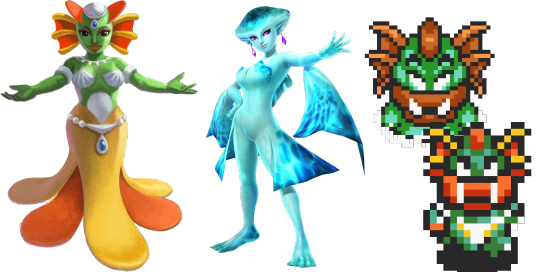
The enemy Zora queen Oren does seem to take after Ruto from Ocarina of Time, as she has a far more humanoid design than the other enemy Zoras that appear in many of the 2D Zelda games. But she does also remain steeped in A Link to the Past, as her Zora's Domain is where Zora's Waterfall was in that game. Oren's design falls more in the middle between the Zora designs common in the 3D games and the enemy Zoras seen in the 2D games.
Rosso
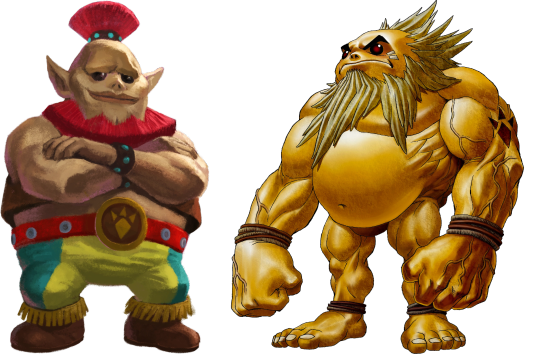
Rosso is a bit of a contentious topic, though he does have obvious ties to the Gorons. He has a belt buckle bearing their symbol and also looks the part with his physique, though he has a few non-Goron traits as well such as ears and fiery red hair. In-universe, he is just a human as Gorons were revealed to sprout from the ground in Tears of the Kingdom, which would make Rosso having Goron ancestry difficult. That said, he still is a clear reference to the Gorons given he is a miner on Death Mountain and he doesn't seem to take after any character from A Link to the Past.
Osfala
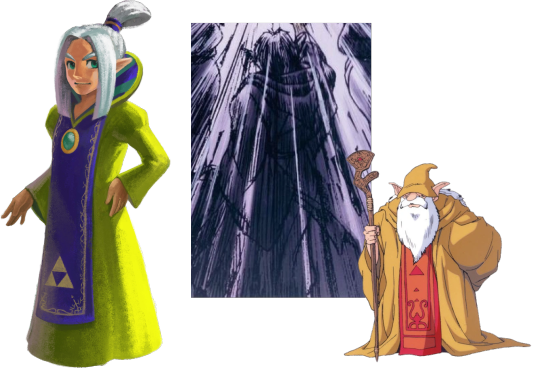
Osfala doesn't take from any character in particular, instead seemingly being inspired by how sagely characters were depicted in A Link to the Past in general. This includes the robed sages of the Imprisoning War and their descendant Sahasrahla. Unsurprisingly, Osfala is also the apprentice of A Link Between Worlds's incarnation of Sahasrahla.
Irene

Irene takes after the witches Syrup and Maple from A Link to the Past (specifically its GBA release where Maple is concerned), which is also evidenced by Irene living in the same hut as them. She lives alongside her grandmother, who may actually be an elderly Maple, given her Lorule counterpart is called "Mapes".

Impa

Impa has been a staple of the series since its inception, appearing since the first Zelda game. Impa in A Link Between Worlds is an elderly lady, which is how she appears in the original NES titles, Skyward Sword, Breath of the Wild and Tears of the Kingdom. Impa in A Link Between Worlds is part of this line of old Impas and doesn't pull from any one incarnation in particular.
Seres
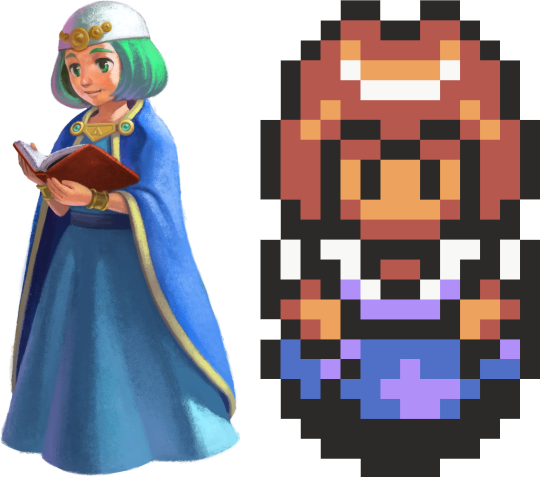
Finally, Seres is a reference to the Maidens from A Link to the Past, who served the same role as the Sages in A Link Between World do gameplay-wise. She is a maiden as well who takes after them when it comes to appearance. Her father meanwhile is the Priest of the Sanctuary. While a similar character did exist in A Link to the Past, he did not have any confirmed family that can serve as a more concrete analogue to Seres.
26 notes
·
View notes
Text
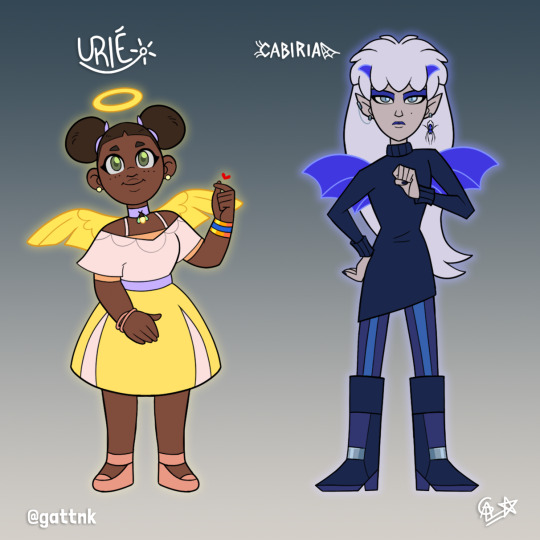
Uriè and Cabiria, you see, they are night and day.
What an interesting pair of rivals! They're probably the biggest opposites in my redesigned cast, even more so than Raf and Sulfus.
Here's my design notes for these lovely ladies:
Their designs came very naturally to me once I cemented their personalities: Uriè is super positive and socially inclined, while Cabiria is solitary and reserved. Based on this, I decided to keep their Prisma Fly colors from the show as their main outfit colors: yellow and indigo, respectively.
While the series has Uriè and Cabiria as paired rivals, in the comic they're paired differently: Uriè is paired with Gas while Cabiria's with Gabi. Since I decided early on to keep Dolce in the cast, I also kept the cartoon's pairings. They also contrasted much more nicely in terms of personality and colors, so I couldn't pass the opportunity up!
Besides the yellow, most of Uriè's redesign is inspired by her comic's counterpart: I picked the lilac and pink colors from there (which is great, coupled with yellow she looks like a breaking dawn!), as well as the hazel-green eyes (while Uriè is not meant to represent one particular ethnicity, I think her eyes were a nod to the black population of the Caribbean and Northern Africa where this eye color is a distinctive trait). She also wears the same gold and blue friendship bracelet as Raf, which may break away from the rest of her ensemble but signifies how their friendship stands out to her.
Cabiria's look from the comic/series might seem too different side by side, but they have the same root: gothic rock/metal and what I can only refer to as "spooky chic". I simply doubled down on this premise: I made her hair long and wild for theatrics, same with the eyeshadow, mascara, lipstick and nail polish; I was heavily inspired by bands like Siouxsie and the Banshees, and The Sisters of Mercy. The silver hair is meant to contrast her very dark clothes, as well as make her silhouette more readable.
Uriè is a little ball of sunshine, so she's plump and the shortest of the entire main cast. Meanwhile, Cabiria is the tallest of the devil girls; her vertical-striped pants as well as her heeled boots bring out her long legs even more.
Their earrings were inspired by their respective mascots: Uriè's pearls are shiny dots just like her firefly, while Cabiria's piercings are linked by a chain like a spider web (her spider mascot hangs from an actual web string).
Mascot placement has some symbolism behind it: I put Uriè's firefly on her choker to signify how her bright words often guide her friends like a beacon. On the other hand, Cabiria's spider hangs from her left ear, just like she often lingers quietly and listens, waiting for the right moment to act.
That would be it without entering spoiler territory for my rewrite fic, I'll Fly With You (which I managed to draft out completely, woohoo!).
Maybe sometime I'll also share my notes on that one, we'll see :P
69 notes
·
View notes
Text
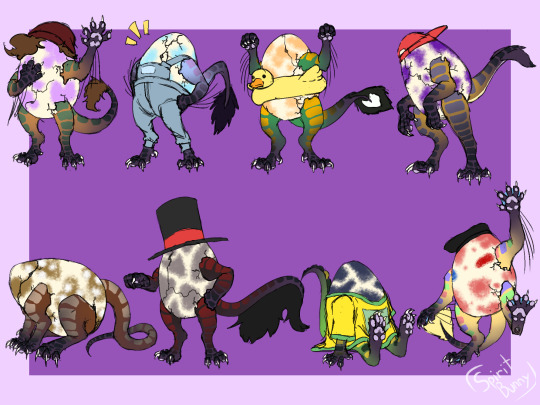
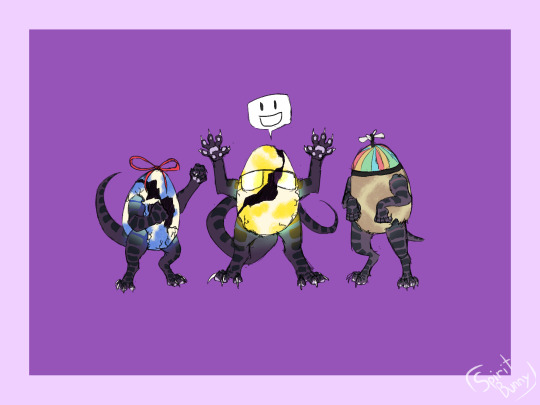
Time for some qsmp egg designs! Since I was working off of the idea that dragons adapt and change to look similar to their caregivers before they hatch, it was really difficult for some eggs since I don't know most of the members of the server + Pomme and Richarlyson have more than two parents. I also based the spots on their shells on their favorite colors, which was also difficult since the wiki doesn't have them all listed.
Anyways I'm glad with how these turned out.
Leaving explanations for all the design choices below for anyone curious.
Some basic details about the eggs, so far their colors have not completely set in so some of their original purple coloring can still be seen; this is most notable for Tilin, JuanaFlippa, and Trump, who all died before their new colors could get past their shells. All of the eggs started out quadrupedal but quickly adapted to stand on their hind legs as well as adapting to have opposable thumbs allowing them to pick up and use items.
Tallulah:
Starting off, she has hair coming from the top of her head and the tip of her tail, the color and style are from Wilbur, however she hasn't seen much of his avian form so the positioning actually comes from Phil. Speaking of Phil, because she has been under his care for quite a while she has also gained many traits from him, such as an extra talon on the side of her heels and pin feathers sprouting from her front legs/arms. Her scales have also started changing to an orange hue, similar to that of my Wilbur's markings, and her secondary colors are a darker green because of Phil.
Bobby:
Bobby is my favorite egg but gave me a lot of trouble due to not really knowing much about Roier so he pulls a lot of traits from Jaiden and the common traits of the fandom's designs. Like Tallulah he has pin feathers coming from his arms and extra talons, however his talons are on the back if his heel. Like Jaiden, he has a feathers on the tip of his tail. While his secondary is a lilac from Jaiden's influence his main color is a duller blue as the fandom has convinced me that he would've been blue if he got to hatch. I had drawn him alive for this, but once dead, he would have a large hole in his shell just under his overalls.
Chayanne:
Probably the easiest design as his traits are about the same as Tallulah's. His tail feathers however are both shaped and patterned like Phil's own tail feathers. His scales are also green and gold to match Phil's clothing. Now that Missa is back, Chayanne's secondary may start to change into a purple/blue or, after he hatches, he may gain bone markings.
Leonarda:
Unfortunately most of her design comes from Foolish, such as her webbed feet, finned tail, and gold and silver coloring, the best I could figure out to add some of Vegetta's influence was to have the silver be more purple than the blue that Foolish has.
Ramon:
Honestly just made Ramón shades of brown since I couldn't figure out much colorwise form Fit. However he does have other features such as a longer tail than most of the eggs, plus he is also the largest of his siblings. His iconic mustache is also made up of his larger spots, which he uniquely has white spots over top of the brown ones.
Dapper:
Dapper was also an easy egg design since Bbh is his only parent, so I gave him the typical black and red palette as well as a longer tail with long fur coming from the bottom. His design might change a bit as I eventually figure out my design for Bbh.
Richarlyson:
I'll be honest, I kinda gave up, I don't really know enough about the brazilian streamers to add any specific feature, so for color he is made up of a light green with alternating yellow and a dark green. He is also the only egg with spines running down his back, however they aren't sharp at all yet.
Pomme:
While Pomme also has the problem of having many parents, I've seen her the most around Baghera, who has a very distinct look. So because of this, Pomme has many duck features, such as tail feathers, pin feathers on her arms, webbing between her toes, an extra talon on the back of her heel, and her main scale color being a more pastel yellow. For main colors, I decided to take the main color from the other french members, make the pastel, and have them alternate on Pomme.
Tilín:
Like father like son, Tilín is, or at least would have been, very blue. He doesn't have any duck features due to his death being so early and that I also haven't decided if I want Quackity to be an avian or not. Tilín is also the smallest egg. :)
JuanaFlippa:
Once again, due to dying so early, she wasn't able to develop a lot of traits or color. The traits she did get was a longer tail and she would've been a light green with yellow accents.
Trump:
Unlike Tilín or JuanaFlippa who have large cracks in their shells to represent their deaths, Trump's shell has become soft and discolored, to the point his spots' original color cant be determined, to represent his death to neglect. Because of this, his limbs are thinner, tail is shorter and his scales are duller; any possible change in his colors is barely noticeable.
#qsmp#qsmp chayanne#qsmp tallulah#qsmp Bobby#qsmp leonarda#qsmp ramón#qsmp dapper#qsmp richarlyson#qsmp pomme#qsmp tilín#qsmp juanaflippa#qsmp trump#qsmp eggs
86 notes
·
View notes
Text

My take on the Turaga Nui, from Shauni's (@legend-as-old-as-time) WIP fic set in Rags' (@magicalgirlmascot ) KNPS AU. Snippets of the fic here and here.
In which the Turaga form a fusion in order to defeat the Rahi Nui, but their past experience with the Hordika venom results in the Turaga Nui taking on a somewhat ...unexpected form. After the battle, the Toa Mata catch up with them. Pictured here is Lewa having the appropriate reaction to finding out his six mentors have turned into some kind of weird dragon-chimera-kaiju thing.
Some design notes under the cut:
The Turaga Nui's form combines traits from the forms the Metru had as Toa Hordika, known in this universe as the Kini Nui werebeasts. So, this was my take on them individually here:

(The Metru's human forms can be seen here) I hope it's fairly self explanatory which features come from which werebeast, but a few other fun design notes...
So, in KNPS, the Toa Kaita look a lot like the Steven Universe fusions, with extra eyes and limbs. The Turaga Nui follows a similar logic but on a more bestial body layout.
The top two arms are the most humanoid, as TN signs in ASL as well as speaking aloud whenever it is practical to do so (i.e. when there is not a Toa of Air attached to their neck). The next two pairs of limbs can function either as arms or forelegs, so the digits are more paw-like.
The wings are obviously based on a snowy owl and come from Nuju's werebeast form. Male snowy owls typically have lighter coloured plumage while females have prominent black bars on their feathers. Nuju in particular would probably have been almost completely white as a werebeast given he's an ice Toa and has white hair in human form. The Turaga Nui, however, is composed of five men and one woman, so I gave them a small amount of barring on the tips of one wing while the other is plain white. (The bars also help tie it back to the badger stripes on their face from a design standpoint)
The Kaita have metallic gold or silver skin, I suggested black and white patterns for TN's colour scheme to make them visibly nonhuman but also distinct from the Kaita.
Shauni felt that there should be more accents of each element's colours, however, so we decided on the "black" scales actually having an iridescent sheen to them.
I'd already been planning to give TN spots similar to that of a newt, but didn't realise until I started doing it that white spots on black combined with the iridescent colours gives the impression of a night sky/galaxy pattern.
I had previously suggested the name "Tien" to Shauni (Turaga Nui = T.N. Said aloud it phonetically sounds like "Tien"). Turns out Shauni had the exact same thought. Furthermore, it's a name in several cultures, various meanings include "heavenly being", "celestial" and "sky" (An etymologically related name is the Chinese "Tianlong", which means "Celestial Dragon")
So, accidentally coming up with a name that means "celestial" and then accidentally making them look like a living galaxy was a fun coincidence.
Also, apparently one of Rags' favourite DBZ characters was named Tien, so that was a plus for her!
The tail has owl feathers but is structurally more similar to the tail of an aquatic newt.
The eyes are based on the Turaga's animal forms but the colours come from their eye-glow. The three eyes visible in the image are Vakama's (green), Matau's (red), and Onewa's (blue)
As previous;y mentioned, photographs of jumping ferrets helped in drawing the dragon's limbs . I also ended up referencing hairless cats to get a handle on what the paws would look like with no fur.
I did do a version that shows the full body pose, which I quite liked, but felt that the cropped composition above was better to show the character details given tumblr's scrolling format
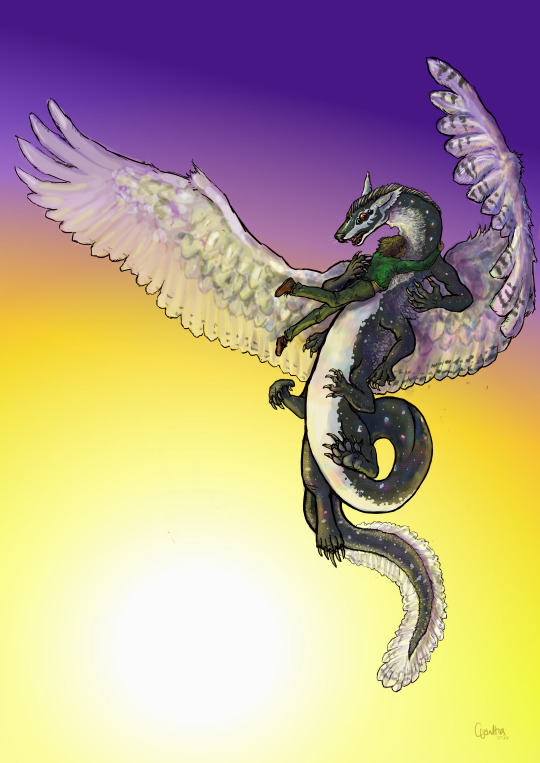
#bionicle au#knps au#lewa#turaga metru#bionicle humanization#human bionicle#in which the turaga nui metru is a kaiju#and also a big dorky noodlebeast
13 notes
·
View notes
Note
I have a question.
I’m drawing an orc woman, and here are the animals I drew inspiration from for her design:
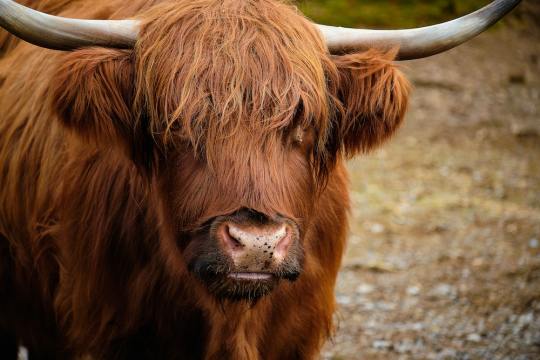

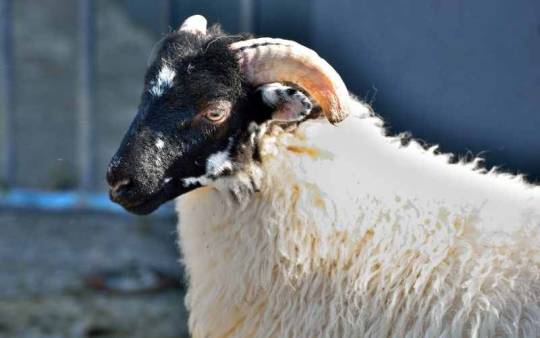
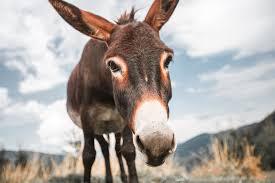

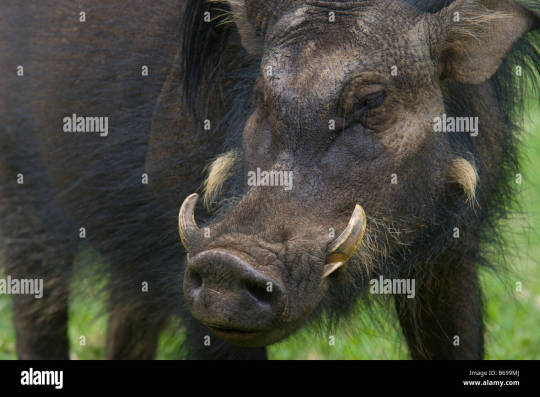
I was wondering how I could blend these animals into a humanoid design.
(image description: photos of several animals. these include a highland cow, a large horse, some sort of wooly sheep or goat, a donkey, a hippo, and a warthog. end description)
the first step is figuring out which distinct traits of each animal you want to utilize, and what they might have in common. I've made a messy little thought map here about it:
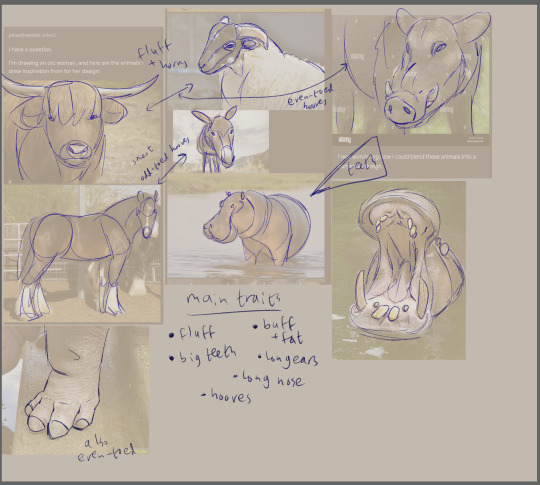
(image description: the same photos as above, arranged in a collage with added photos of hippo teeth and feet. the photos are faded and dark blue lines are drawn over them to trace the main shapes of each animal, alongside connecting arrows and notes pointing out the similarities between some of the animals. end description.)
The highland cow and the sheep both have fluffy hair or wool, and a pair of horns. They are also even-toed hoofed animals, as are the hippo and warthog. the horse and donkey are odd-toed hoofed animals. The hippo and warthog both have really big teeth. All of these animals are ungulates, most of them have large ears and a lot of muscle, and all of them have a long face.
Orcs are usually drawn big and muscular and fat, with big tusks, so the most obvious route here is combining the warthog and hippo teeth somehow. I think the hippo feet are the best bet for orc feet, as they're more flat and soft, easier to adapt to a bipedal design.
an orc that takes features from all these animals will probably have a pretty hairy body, maybe curly hair to reflect the sheep wool. it would also be interesting to see an orc with horns, as that's not super common in most depictions of orcs. I would also suggest leaving the longer face shape rather than trying to make it very short and humanoid.
I've made a couple of test sketches as a visual aid. this is just my concept based on your idea, so your final design will probably look different as you work out what you really want the character to look like.

(image description: a simple sketch page of an orc woman using features from the animals above. She is large and hairy, with extra hair on her wrists and ankles like the horse's fluffy feet. She is wearing her hair in braids and she has a small pair of horns on her forehead. Her nose is long and round with large nostrils. She has long ears. Her teeth are visible as a pair of warthog-like tusks and two big teeth coming out of the front of her lower jaw. A small eye sketch shows horizontal pupils. end description.)
22 notes
·
View notes
Note
Character ask game: #3, #48, #49 Vincent Valentine, of course!
What first drew you to this character?
What drew me to Vincent in the first place is a bit convoluted and very silly, but also I was like 12 when the OG came out so bear with me here.
So my mom has ADHD and only discovered this in the past couple years, meaning she spent her entire life trying to accommodate a condition she didn't realize she had, and this led to some "weird" choices—one of the most notable of which was literally color-coding her children.
I have five siblings, and we were all assigned a color to make it easier to tell what belonged to who. Older sister: green. Older brother: navy blue. Younger sister: purple, which was also her first word. Younger brother: sky blue. Baby sister: turquoise, because our folks tried pink but she rejected it from like 6 months old.
My color, if you hadn't guessed, was red.
What’s your favorite physical/design feature for this character?
This is hard to answer because Vincent's design, while being very distinct, is also really...transient, I wanna say? Most of his iconic physical features are temporary, they're clothing or accessories, we don't get to see a lot of him.
I really love Vincent's hair, but I always have the most fun drawing his eyes, so we'll go with that.
What’s your favorite personality trait in this character?
I actually really love Vincent's sense of responsibility. It's gotten him into trouble (that is literally how he wound up in his current condition in the first place) but it's also the only thing that drives him forward at any point in his entire storyline. He has trouble keeping it from bleeding out into guilt, sure, but without that sense of responsibility he never would have gotten out of his coffin in the first place.
I know he gets a lot of shit for being callow and weak-willed and dramatic, people call him obsessive for what happened with Lucrecia and stupid for just kinda staying in a coffin for decades while the world burned down around him, but I think that's doing him a disservice.
Vincent put himself to rest out of the same sense of responsibility as what got him killed in the first place. His presence, as far as he's concerned, is what caused everything to go wrong. He believed that he drove Lucrecia into a relationship with Hojo by coming on too strong, he believed that Sephiroth was his child and therefore he was to blame for giving Project S its lead subject, he believed that his inability to stop them from creating a monster is why he didn't pass on after Hojo shot him—he genuinely believed that the Lifestream rejected him, that what he'd done was so horrible that even Gaia couldn't forgive him.
So when he was locked away, he stayed. If no one ever found him, he couldn't hurt anyone else. He couldn't do any more damage to the world that he's been damned to haunt for the rest of time. In hiding, Vincent was removing himself as a mitigating factor in the continued hardship of the world at large, because he already felt responsible for causing so much harm. He thought he was doing the right thing, he thought he was protecting everyone else, he thought he was keeping the few loved ones he might have left safe.
He was wrong—but if he weren't, there's no denying that it would have been the right decision.
(From the honest favorite character ask game.)
17 notes
·
View notes
Text
How I invision Gwen Stacy
Super pale, almost horrifyingly so, to the point her veins are visible around he face and body
Her freckles are so much more than it canon and they pop against her skin, she used to be insecure about them until she grew to love them
Very blonde, has blonde eyebrows and blonde eyelashes
Silver piercing and jewellery girlie, after eyebrow, she quickly added more ear piercings until she grew bored of them and pierced her nose, usually studs or spikes
Curly haired, because all of my favourite characters are curly haired
Her hair is always changing but she has to distinct traits, it’s short and multicoloured. Mostly it’s pink, usually blue and purple, sometimes even green and black. She lets it length range from shoulder length to fluffy pixie cut.
She loves partly shaving her head too. Sometimes as side shaves, sometimes as an undercut, if she’s feeling particularly fancy she’ll even add shaving patterns on her undercut, spider web pattern for example
Rarely uses makeup but if do, her designs are always adventurous and fun, with crazy liner designs and multi coloured mascara, she doesn’t like base or lip make up, at least not as much as eye
Tooth gap !!!
She has a very defined cupid bow
Her body is much more toned and muscular, her arms specially from webslinging and drumming but her legs too, since most of her fighting style consist of kicks
Flat AF
Broad shoulders !!!
She’s also very scarred, due to her clumsiness during fights and tendency to push her self to the extreme, especially on her skull since she gets concussed a lot
#I just see her as a Victorian sickly child that discovered monster drinks and abuses the fuck out of them#maybe one day I’ll be confident enough in my art to post it here#but for the meantime here you go#gwen stacy#ghost spider#spider gwen#spiderverse#Spider-Man#spiderman into the spiderverse#spiderman across the verse#headcanons#character design
36 notes
·
View notes
Text
My main issue with senti-monsters
Alright, so first of all, this is not an essay about the senti-Adrien, senti-Felix, senti-Kagami, senti-Chloe or any other senti-person theories. There are a lot of complex theories and debates and discussions about the ethics and moral implications around it.
No. This is an essay about missed potential surrounding senti-monsters, which is probably one of the least relevant things you’ll need to hear about it. This isn’t about poor execution or predicting where the show will go. It’s not about someone who did something right (well, not completely), or anything like that. In fact, I am veering far away from most of the usual senti-monster topics. So, if you’re hear to discuss humans born of senti-monsters or anything like that, this is not for you. Sorry.
Now, first of all, I have opinions about the name senti-monster. Now, it’s not what you think. I’m not one of those people about to advocate for using senti-being here. No. I’m here because I want to ask: “Where are all the monsters?”
My introduction to the Peacock was a black eyed woman ripping a monstrous butterfly made of grief painfully out of Hawk Moth against his will. This thing was huge, massive, and scary. It’s design was creative and clearly reflected that this thing belonged to Hawk Moth, and he didn’t have any say in its creation whatsoever.
My next few introductions were promising. A lolipop monster made out of a need for processed sugar from a baby, and I read that very well, and a simple monster made from hunger which was nearly impossible to defeat, which yeah, giant frog that’s basically a moving mouth. I can get behind that.
But unfortunately, we also had Senti-bug, and that kinda derailed things. Now, don’t get me wrong. I love Senti-bug, and the moral implications behind her and her destruction are beautiful, and it raised the sentiment of “Good God, the Peacock’s ability to create life and take it away in the snap of their fingers is horrifying”, but alas, it set us down the path of human monsters, which is most decidely not monster-like.
See, what I thought was going to happen was that the senti-monsters would be representative of deeply buried emotions, the dark, forbidden secrets that you shamefully keep locked up and hidden away for no one to find, and that their creations would be a very unpleasant experience for their hosts.
The design team has proven with it’s design ideas to be more than capable of being up to the task. The akumas especially are amazing design wise. Most of them have a unique silhouette, are recognizable at a glance, and you can tell important character traits with them. (Except Vanisher who does not have a distinct character design and doesn’t even have their own episode). There are some pretty obvious flops, yes, but even those often have a reason. Some of these akumas do not look good at all, but usually there’s a reason behind it. Ie, Aspik’s hood is concealing his hair, reflecting his need to hide himself and a visual reference to Hawk Moth, Reflekta’s design is almost painful, but memorable, and the Bubbler reflects his childnessness of both his worldview and his influence, blowing bubbles.
However, it was clear that akumas were begining to stagnate. It was obviously getting harder and harder to come up with realistic reasons why a character might lose their cool, and the loads and loads of characters was starting to become worrisome if the series wanted to keep up the momentum and focus on the characters they already had.
The obvious solution, I believed, was making the Peacock target deeply buried emotions, setting up a one-two punch. Either you could become an akuma, losing yourself to your flaws in a moment that you lose control, or you could bury your feelings until they became strong enough to become a senti-monster, a living embodiment of a feeling you never wanted revealed. This would start a catch-22, either you deal with your emotions in a healthy way and resolve them, hopefully in a way where neither of you lose your cool, or you avoid it and it turns on you.
This would begin to force people to move things very quickly or suffer the consequences. Long simmering grudges you know are stupid and pointless get brought to the surface. Deep fears come alive. Secrets you keep hidden from everyone come alive. It could also affect the heroes too, without completely incapicatating them. For example, Adrien’s hidden resentments could come to life, or Marinette’s crush may decide to confess regardless of her say so. Even better, you could take inspiration from Fu’s montster and make the host have a strong emotional reaction to them. From panic to anger to fear to hopelessness. It’s rife with drama.
Now, originally, the Peacock was meant to be used for good, so how would it work if they were heroic? Well, the same way Shadows work in the Persona series. Yes, each character rejects their shadows, but when they accept their Shadows, they become allies. Yet, when rejected Shadows are a problem. It’d be a case of Bad Powers, Good People, where the Peacock’s abilities are dark and creepy, but could be used for good, not just for combat, but for self-growth, and it’d absolutely deserve the moniker senti-monster.
This would let us see the heroes deal with talking people down in their own ways, each with their strengths and weaknesses. Queen Bee could cut straight to the heart of the matter and tell you what’s going on, no frills, but that might also hurt people and she might have to learn how to stop being callous but still use her skill at dissecting people and seeing their flaws. Ladybug may be kind and compassionate, with a lot of people looking up to her, but she might have a tendency to miss the point. Rena Rouge may be confident and have an internal strength that allows for no bullsh*t, but she can also be pushy. Carapace may be calm and non-judgemental, but might need to work on pushing people out of their comfort zone. Chat Noir would be great at this, being that he is very naturally empathetic, and tends to understand what people are dealing with quickly, but he’s also conflict avoidant, and would be screwed if it happened to him.
Plus, I’d be able to see monstrous representations of problems and each character needing to accept terrible parts of themselves or be afraid of others learning about it. And I’d get to see fan material that leans into monsters and that creative side a bit more. Like debates over what Alix’s monster would be or represent, or fan art of Rose’s sick looking unicorn design.
#sentimonster#miraculous ladybug#miraculous lb#ml analysis#writing ideas#Analysis#self-indulgent#peacock
83 notes
·
View notes
Text
one more ms pain.t shingyoku because,
its like, ressembling most takes of them ive seen aka the forms are 2 distinct people while i say theyre one but

I much prefer thinking theyre one shapeshifter because it makes them stand out imo but that one more common take is ok too i dont dislike it ok?
Edit: I kind of hate that take now lol. Its mainly because I find people doing thay dont deepen it at all and ditch the yin yan orb form
Or i think it depends which personality people give them,,, i imagine in this take they kind of complete each others, the girl is a big cheerful and mischevious silly while boyo is more the collected and solemn kind (but still gentle). In my prefered take "Shingyoku" is their personal name, but if theyre 2 people "Shingyoku" is a title and both have their own personal name
There I draw them different than my usual take. My usual has same face traits & height regardless of form taken with lots of mirrored details in the designs, while these two are lot more distinct. Tho they still try matching because theyre sillies. I still draw the dude cute because in lots of takes ive seen he looked like lowkey ugly generic isekai looking protagonist and I prefer my longed hair feminine looking bishies :woozy_face:. When i see him drawn cute tho i explode. I dont think ive seen weird looking takes on the girl design but im amused on how people interpret what looks like horns on her head. Theyre definitely horns to me. The dude also have some in my take hidden by the funny futo onmyoji hat.
Also thats a ship and the main point of the story I came up with for this one take tbh, but its far less detailed than all of what I imagined for my main "all forms are one person" take crrr
These two act like parents for Reimu and they break kneecaps together (elbows for ghosts)
I talk too much about a forgotten touhou character w no dialogues damn and ive already planned a long post with all of what ive written.,
32 notes
·
View notes
Text

Heres the full pic of Calamari! This is just their clothing design, not their actual weight. I used a base to make sure I got the clothes on neatly. I hope it looks okay! And below is their long ass profile! I haven't decided what team to put them on the Bucci gang or La Squadra but they do give some squadra vibes... well what do you all think? where does this poor soul get to go???
🩸=la squadra only traits/dialogue
🤐=bucci gang only traits/dialogue
no emoji means it happens regardless, so sorry if its such a clusterfuck! once I finally decide im getting rid of the alt dialogue/traits!
Name: Katrin Kocteau
Allias (if applicable): Calamari
Namesake: The Cocteau Twins
Nicknames: Callie, Kat, Kit Kat, Gattina, Stella, Luna, Starlight, Sole, Carina, Cara, tesoro, bella, bambina, Sourpuss, Kitten
(usually used sarcastically): Comrade, ,little sister,Sunshine, Moody boobs, Boobs McKenzie, Sourpuss
Nicknames for others:
🩸Lulu, Schatz, Rubin
Big brother, comrade (gelato and calamari jokingly call each other comrades due to both being oppressed by the Soviet Union )
🤐Abba,Diamant ,gloomy fuck/blues, Leo, piss monger,
Löwe,, honigbiene, liebling, Kuschelbär, Bärchen, Schatzi, Engel, süße,
(Used in a joking/sarcastic way) Arschloch, Sonnenschein, Eselhengst, Dummkopf
Age: 25
Birthday: July 12th
AMAB/AFAB/Intersex: AFAB
Gender Identity: Agender; They/Them sometimes she/her…doesn’t correct strangers out of exhaustion
Height: 5’3 160cm
Weight: 175lbs
Handness: Left
Hair Color: Burgundy/Wine red
Eye Color: Violet
Type of Voice: soft, monotone, flat, they speak very softly with a Berlin accent. You have to listen very hard to understand them due to how softly they speak. It will go from soft valley to booming peaks when agitated enough.
Eyesight:. 20/40
Race and/or ethnicity: Caucasian; German
Hometown: West Berlin, Germany
Current Residency: Napoli, Italy
Religion (if applicable): Non practicing Christian
Moral Alignment:
🩸 evil neutral
🤐 lawful good
MBTI Personality Type (Optional): INFJ-T
Medical & Dental Health:
Dental- vitamin deficiencies in childhood causing weak teeth, many fillings and crowns
Physical- Chronic tension headaches, vitamin deficiency (vitamin D and Calcium)
Mental health:
PTSD, ADHD inattentive type, Major Depression, generalized anxiety disorder w/ panic attacks
Phobias: Claustrophobic- caves and tunnels specifically
Phonophobia- HATES loud noises and others talking too loudly
Astraphobia- related to phonophobia
Germaphobic - fears gastrointestinal illnesses the most
Socialphobic- is on edge around crowds and people they don’t know too well. Very reserved and secretive
Arachnophobia - self explanatory
Fears cursed numbers (4,13, 666)- acts a bit more covert towards it than Mista-(ex add 1 more or less spoonful of sugar to their coffee to avoid 4)
Scars/burns/birthmarks/tattoos: self inflicted cuts and scars on arms and thighs due to poor coping mechanisms
Other distinctive physical characteristics:
Criminal Record:
Murder her partner Teo in a crime of passion after finding out he was cheating for the 3rd time
Awards & Education:
General Education Diploma, Majoring in Forensic Science in University,
Excelled in foreign languages(Italian and Russian) and art class
Past Experience:
Calamari is cynical, bitter, a perfectionist, and never allows themself to be vulnerable. Any mistake they make they severely punish themself with. They lash out at themself because they believe they deserve it. Their forearms and thighs are full of scars and self inflicted cuts. They show Themself no mercy so they sure as hell aren't showing it to any of their targets. They're not your typical sadomasochist, not a masochist because they enjoy it. They don't enjoy it at all, but they believe they truly deserve it.
They always had a strong interest in the paranormal and true crime. Due to religious restrictions and profitability they dedicated their education to their forensic career. They always fixed themself to the smallest details rather than the bigger picture. Small details that are often overlooked could derail the entire case and justice for the victims could be lost. Their resolve shines the brightest when they dedicate everything they have to speak for the dead.
The corruption in the justice system and bribery infecting all the way down to their forensic team made them lose the spark and desire they had for their work. There’s nothing they could have done anyway since it was them vs the majority and they needed every lira to help pay off their exs gambling debt.
Calamari takes extra work to help pay off his debt only to find out that he was cheating on them and then kills him out of a crime of passion. Now Calamari is left with a body and heaping amounts of gambling debt that isn't theirs. They join Passione to seek protection and to pay off their debt.
Sexual History (for characters 18+ ONLY):
Teo, Her ex partner
Currently:
🩸Illuso
🤐 Abbacchio
Thoughts on love:
They’ll swear up and down that love is worthless and a waste of time. They’ll say they never felt better by themself now that her ex Teo is gone, but they’re lying to hide the loneliness. They hate kids but are very domestic and secretly want a partner to take care of physically and emotionally. They are very touch and love starved and needs the perfect partner to give them hope in humanity again even if they only learn to trust 1 person.
It takes a long time to develop a crush due to their sexuality and trust issues. They subconsciously become more mellow and obedient around the one they develops a crush on. They’ll always listen to abbacchio’s orders. They’re no brown noser but they try to be as obedient as possible. They’re secretly very submissive.
They’re only submissive to Illuso in private and only when he’s being nice. 90% of the time They’ll ignore him or berate him if he teases them. They don’t take being teased/bullied lightly. They avoid him and act tough around him because they don't want their weakness known or the fact that they would like someone that cruel…as if they aren't cruel themself-they won’t admit it-they’re a hypocrite and that their actions mirror his. The only difference is Calamari is only cruel to their targets and enemies. They give their teammates mutual respect until they do something to ignite their ire.
Sexual and/or Romantic Identity: Demisexual, Panromantic
People they like:
“I don’t like people. Nobody can be trusted.”
Calamari keeps people at arm's length but they’re not completely cold. They warm up to others after they prove they are trustworthy enough.
To tell if they like you is them allowing you to be near them. Letting you sit next to them , letting you hug them (briefly), or playing with their hair. They will also joke with you, or make dry remarks. Best friends will be allowed in their room, play video games with them, and they’ll share secrets about her past and spill tea about others. You tell them a secret as a best friend and they’ll take that secret to their grave. Once you become their best friend/and or partner they’re loyal for life so don’t betray that trust like their ex did.
🤐 Bucciarati, Abbacchio, Fugo are the ones who they trust and respect the most.
They won’t show it but they like giorno, narancia, mista, and Trish too. They took a little longer for them to warm up to. They will send sarcastic remarks and jokes their way as their own way of showing friendship.
🩸 they’re very hard to read, it even takes Risotto a split second to figure out what they’re feeling with their stone cold resting bitch face and monotone voice. They don’t hang around after meetings, so the only one who’s able to get a glimpse on how they feel is Nosey Illuso or Formaggio by spying on them.
They like Risotto and prosciutto but is heavily intimidated by them. They warm up to Pesci the quickest- Object stand users stick together.Sorbet and Gelato essentially adopted them from the moment they met, they’re friendly but they have fun making Calamari uncomfortable with the PDA. They slowly warm up to Illuso and Formaggio. Somehow they are able to find common ground with them… I wonder why- it’s almost like they can read their mind. They’re fine with Ghiaccio as long as he isn’t yelling so it’s very rare for them to enjoy his presence. Melone just disgusts them, but they put up with him for the sake of the team.
People they hate:
They’re known to hold some strong grudges. It took forever for them to forgive Mista for taking their slice of strawberry cake. They especially can’t stand children and babies because of the noise. Also isn’t a fan of yappy dog breeds.
They hate anyone who gets in the way of their goals or inconveniences them. They hate their ex due to the turmoil they dealt with because of him and hates themself for allowing them to step on them for so long.
They hate the boss because he’s an inconvenience to their livelihood and just life itself.
🩸
Nothing pisses them off more than a bunch of bootlickers getting in the way of them and the team getting the boss’s daughter to find out his identity. The holier than thou attitudes of Giorno and Bucciarati make them hellbent on wanting to set their enjoyment of humiliation aside and give them severe curb stomping.
🤐
It wouldn’t really be considered “hate” but Giorno annoys them. They thinks he’s too naive and preachy …absolutely not because They’re jealous of his natural born talent or anything, don't be ridiculous. They’re a million times more polite about it than abbacchio is. They just groan or ignore him or cuts him off with “you’re too young to understand” or “you wouldn’t get it…” “*groans*whaaaat? I’m busy…go brown nose Bucciarati instead kid.”
They didn’t care much for Trish believing her to be nothing more than an ungrateful spoiled brat. They both grew up so differently that it was hard to bond at 1st. Thankfully neither of them are that stubborn to try to understand each other.
Dreams for the future:
A peaceful life with her perfect partner. A cozy home in either Austria or Sicily with many pets and an art studio. They crave normalcy and freedom of expression.
Relationships(name a person that they have a connection to and what their relationship is like[friend, enemy, Ex, current lover, family , etc.]):
Teo- Ex
🤐Abbacchio-Current partner
Bucciarati- Confidant & Leader
Fugo- Good Friend
Narancia-Good Friend
Mista- Good Friend
Giorno- Friend
Trish- Friend
🩸Illuso- Current Partner
Formaggio- Good friend
Pesci- Good friend
Prosciutto- Mentor & Callies Secret not so secret crush
Risotto- Leader
Sorbet- Good Friend & parental figure
Gelato-Good friend & parental figure
Ghiaccio- tolerable friend in small doses
Melone- Tolerates- wishes they didn’t know him
Quotes (what do they say often? What’s their life’s motto?):
“How about you go play in traffic?”
“”Kiss concrete douche!”
“Eat asphalt!”
"Everyone shut up I'm doing _______!"
views on life “There are 3 rules in life that must always be followed:
1. If you’re going to do it right- do it right the 1st time.
2. Always be punctual. If you’re early you’re on time. If you’re on time, you’re late.
And 3. Be self reliant. Never burden others. If you have a problem- fix it. Don’t know how? learn. This is the true way of life.”
“ Do you wanna X? Because that’s how you X.”They say this phrase a lot when someone is doing something stupid or if they had enough of someone and are threatening them.
🤐“Do you wanna walk all the way to Pompeii? Because that’s how you do that if you keep trying to turn down my music smartass. YES it needs to be that loud. I’m trying not to fall asleep at the wheel. If it bothers you so much, you and Giorno take the wheel, I’m laying in the back and taking a nap. Don’t fuck up and crash the car or my geist will haunt you panna.”
🤐🩸“Were you even listening to a word I was saying? Sigh… you’re such a disappointment, why do I bother with you?..”
Disregarding a mista conspiracy theory/ghiaccio rant 🤐🩸“There’s literally not enough adderall in the world for me to listen to whatever bullshit you're word-vomiting out..”
Taunting illuso back🩸“Make you a sandwich ? How about you earn it 1st. make yourself useful and shine my boots till I can see my reflection in them. Then mayyybe I’ll even think about it.”
🩸Receiving a hit “Who’s funeral am I facilitating?”
🩸“Halt die Schnauze! Would it kill you to not scream like a verdammt banshee every 5 minutes?!”
🩸Defending their stand” Why would my stand need to be strong when it doesn’t have to? I let gravity do all the work for me and I don’t have to break a sweat. I can move anywhere I want, and don’t have to worry about anyone reaching me. It can throw you around like a lousy rag doll and you’ll be helpless to do anything about it. I don’t need to be strong to take your sorry ass down. I may need protection now and then but I’m still the queen on the chessboard. I can go and attack from ANYWHERE”
🩸Apprehensive about betrayal“I’m used to living frugally. I don’t see how 20 million lira is too little to live off of. I don’t think it’s worth going against the boss for more. We don’t know who he is or what he’s capable of.”
🩸Expressing denial and hiding their feelings “Love? Absolutely disgusting. It’s a useless feeling and only sets you up for failure. There’s nothing worse than being tied down with dead weight who will either cheat or become bored of me or I’ll be bored of them. Material goods bring me just as much happiness as an annoying man/woman ever could. I buy a new pair of boots or a handbag, get tired of them- go set them aside in my closet, and buy new ones. Wash, rinse, repeat. Your life is much less difficult when you think with your brain instead of your heart… or your balls if we’re being realistic.”
Hobbies;
Painting, Drawing, Playing Video games, clothes & shoe shopping, make up, petting cats, napping, and eating
Habits:
Is secretly superstitious. Avoids numbers that they hate, won’t open umbrellas inside, walking under ladders etc… The only exception to their superstitions is black cats.
🩸Man spreads on the couch out of pure passive aggressiveness since there’s never any room for them to sit
They have a soft spot for black cats and their cats Depeche and Muse are their pride and joy. They greeted them with open arms completely ignoring their teammates all together thinking they were excited to see them when they got back.
🩸They have a kangaroo pouch to hold them in when she’s working around the base/hideout….
🩸They love traumatizing teammates by tricking them into showing them shock sites and laugh maliciously at their reaction.
🩸They has a very dark sense of humor so it usually plays off well with sadistic or edgy teammates.
.They try to hide their smiles and giggles by covering their mouth. This habit slowly ceases once they feels more comfortable around others.
Calamari hides their red face when they’re aroused or embarrassed .
They sigh and huff a lot when they’re irritated.
They enjoy coming up with unusual torture/interrogation methods. They held a bamboo skewer up to someone’s eye, threatening to turn their eye into a kabob and lobotomise them.
They’re very diligent in working on their Italian vocabulary and accent. They get help from Fugo from time to time when they have trouble pronouncing something. Or on the hitman team…they’re stuck with Ghiaccio. Which you think would be a disaster but he’s pretty patient with those genuinely wanting to learn Italian, but that doesn’t mean he won’t have his typical outbursts.
They’ll get annoyed with him and his noise and will spite him by only speaking in German the rest of the day until he finally breaks and begs them to stop. He doesn’t know German but he knows damn well they’re talking shit about him to Illuso .
They aren’t able to physically defend themself in hand to hand combat so they are well equipped with spiked knuckles and a stun gun strong enough to take down a bear. They have a hand gun that they are taking lessons with, they’re competent but their aim isn’t as good with it as they are with their stands bow.
Quirks/Unique personality traits:
They won’t look anyone in the eye or call anyone by name directly unless they’re very close with the person.
Doesn’t announce when they’re here or when they leave. They just walk right in without saying a single hello or I’m back/here.
In the very beginning they spoke a lot like an NPC with very short to 1-2 worded answers. Once they became more comfortable with their team they said more than 2 words.
Pet peeves:
Talking over or interrupting them while talking
People acting smarter than they really are
Excessive noise (barking dogs, talking too loud, yelling , crying children, Ghiaccio , etc)
Gratuitous PDA
Not obeying rules (excluding missions)
Being late
WAKING THEM UP
Invading their personal space
Moving their things- they have them specifically where they want them
ILLUSO
Having wet hair and clothes (sensory issues )
People whispering (they’re paranoid)
Do you have a stand?(if not ignore the questions related to it): Yes, Via Black Sabbaths Arrow
Stand type(humanoid, object, drone, etc.): Object
Stand appearance (if you don’t have a picture): no set visual yet- but fantasy type bow and arrow that looks similar to a moon…Still working on it.
Stand Name: Black Celebration
Stand Range: 15 meters , 30 meters (how far stand can shoot max)
Destructive power: D(calamari must rely on gravity and their surroundings to use to their advantage. Their stand technically isn’t meant to be used in combat but their creativity has helped them and their teammates out of life or death situations)
Speed: A(variable, Calamari learns to have more control over [lower/strengthen] the suction and ejection the black holes)
Range: A(variable, how far Calamari arrows shoot)
Stamina/persistence: D (can stay inactive for an extended period of time up to 3-4 hours before activating.)
Precision: C
Development potential: A
Stand Abilities:
Black Celebrations intended role was for contingency plans and escape routes. Calamari and their stand is bursting with potential. They're full of creativity and are always thinking of ways to be several steps ahead of their enemy.
Black Hole traps: like real black holes, they are invisible to the naked eye and aren’t really black. BC can be shot to set up a booby trap for a target to unknowingly get in its range to be swallowed up and spat out another hole wherever Calamari pleases. It can stay dormant for roughly 3 to 4 hours so they don’t need to chase down their target but they can’t stray too far away from the town/city they’re in. To distinguish the difference between their target and civilians is to periodically check through the hole. Which isn’t too difficult when working on investigating targets beforehand. But these traps are basically useless if they don’t have this information, unless they stay nearby. With that, it will activate with the snap of their fingers
Chaining: This is the ability everyone relies on calamari the most . Calamaris 1st learned ability, they can take up to 8 shots at once roughly about 7-30 meters in between each hole max to get themself and her teammates out of a location. The more arrows they shoot the less they will go. It’s better to go one at a time. If they only shoot 1 it simply just takes them through the other side of something, like the other side of walls, into other rooms, vehicles, etc.
Effect beacon/ redirection: With slowing down the way BC inhales/exhales matter, it can expand the effects of certain other stand abilities or redirect them (ex Grateful Dead aging fog, Purple Hazes virus,)
Redirecting projectiles work well with their stand too (Aerosmith’s shots) though; it doesn’t work well with Sex Pistols, the sudden change in surroundings disorientates them losing control of the bullet. There’s limits to how much weight BC manipulates. It can handle roughly double their own body weight (300-350 lbs) when in the most dire situation they can transport a full sized sedan through a wall with the help of another pulling back the bow.
Remote vision: Calamari can see into any black hole at any time but only one at a time. They are limited to 7 seconds of looking in and have some time before they can do it again or else they get severe headaches.
Stand weaknesses:
No defense or ability to fight back: BC has no ability to defend itself in close ranged fights due to being an object based stand. It requires a few seconds to set up 2 portals to send their attacker away or for them to escape and sometimes they might not have that precious time.
Loss of senses: when looking into their black holes they can only sense what’s going on in the hole. This leaves them vulnerable for an easy ambush so they need someone nearby when they do this.
Low endurance: BC is fueled by Calamari’s adrenaline. Their anxiety and fight or flight response is what helps make their arrows manifest. After a long arduous fight it saps their energy and makes them incredibly exhausted and drowsy. They usually sleep on the ride after a mission, resting their head on whoever is next to them.
Battle Cry: N/A
--------------------
Favorite Band: Alice in Chains
Favorite Color: Violet
Favorite Animal: Pallas Cat
Favorite Movie: The Amityville Horror
Favorite school subject: Art
Favorite Meal:
Appetizer/Side dish: caprese salad
Entree:Sauerbraten w/ sauerkraut
Dessert:tiramisu
Drink:cappuccino
Snack: soft pretzels w/ mustard
Food/Drink Dislikes:
Garlic, sausages links(all kinds), eggs, sweet pickles, processed cheese, canned foods(excluding pickles)cream soda, root beer, mint chip ice cream, mint anything
Additional notes (any other details you wanna add about your OC?):
#jjba#la squadra#jjba part 5#jjba x reader#la squadra x reader#my ocs#beryls fart art#la squadra esecuzioni#bucci gang#bucci gang x reader
9 notes
·
View notes